перец чили
- перец чили
-
перец чили, перца чили
Слитно или раздельно? Орфографический словарь-справочник. — М.: Русский язык.
.
1998.
Смотреть что такое «перец чили» в других словарях:
-
Перец чили — Перец красный острый, или перец чили высушенные плоды определённых сортов тропического полукустарничка Capsicum frutescens или Capsicum annuum, пряность, имеющая жгучий вкус. Название перца созвучно с названием страны Чили, однако происходит из… … Википедия
-
перец чили — сущ., кол во синонимов: 1 • перец (46) Словарь синонимов ASIS. В.Н. Тришин. 2013 … Словарь синонимов
-
Чили (перец) — Перец чили Перец красный острый, или перец чили высушенные плоды определённых сортов тропического полукустарничка Capsicum frutescens или Capsicum annuum, пряность, имеющая жгучий вкус. Название перца созвучно с названием страны Чили, однако… … Википедия
-
Перец красный — Перец чили Перец красный острый, или перец чили высушенные плоды определённых сортов тропического полукустарничка Capsicum frutescens или Capsicum annuum, пряность, имеющая жгучий вкус. Название перца созвучно с названием страны Чили, однако… … Википедия
-
Перец — … Википедия
-
Чили перец — свежие или сушеные стручки около 4 см длиной. Они бывают зеленого, желтого, красного или оранжевого цвета и жгучего вкуса. Возделывают этот перец в тропическом и субтропическом поясе, и там его едят и в свежем виде или тушеным в виде салата или… … Кулинарный словарь
-
Чили соус — очень острый соус для заправки многих блюд в кулинарии Юго Восточной Азии. Основой соуса служит стручковый перец чили. Кроме этого, в соус входят помидоры, репчатый лук, имбирь, гвоздика, свежий сладкий перец, корица и чеснок. Добавим сахар и… … Кулинарный словарь
-
перец — задать перцу… Словарь русских синонимов и сходных по смыслу выражений. под. ред. Н. Абрамова, М.: Русские словари, 1999. перец мужской половой орган, елдык, перчик, соль, кустарник, мужской член, изюминка, достоинство, капсикум, пасленовый,… … Словарь синонимов
-
Чили кон карне — с фасолью и томатами Чили кон карне (исп. chili con carne), также известно просто как чили блюдо мексиканской и техасской кухон … Википедия
-
Чили — Республика Чили, гос во в Юж. Америке. Название на языке индейцев араваков, у которых чили холод, зима , что связано с их восприятием снежных вершин Анд. Географические названия мира: Топонимический словарь. М: АСТ. Поспелов Е.М. 2001. Чили … Географическая энциклопедия
| Chili pepper | |
|---|---|

|
|
| Scientific classification |
|
| Kingdom: | Plantae |
| Clade: | Tracheophytes |
| Clade: | Angiosperms |
| Clade: | Eudicots |
| Clade: | Asterids |
| Order: | Solanales |
| Family: | Solanaceae |
| Tribe: | Capsiceae L. |
| Genus: | Capsicum L. |
| Varieties and Groups | |
|
|
| Synonyms[2] | |
|
Synonymy
|
Chili peppers (also chile, chile pepper, chilli pepper, or chilli[3]), from Nahuatl chīlli (Nahuatl pronunciation: [ˈt͡ʃiːlːi] (listen)), are varieties of the berry-fruit of plants from the genus Capsicum, which are members of the nightshade family Solanaceae, cultivated for their pungency.[4] Chili peppers are widely used in many cuisines as a spice to add «heat» to dishes. Capsaicin and related compounds known as capsaicinoids are the substances giving chili peppers their intensity when ingested or applied topically. While chili peppers are (to varying degrees) pungent or «spicy», there are other varieties of capsicum such as bell peppers (UK: peppers) which generally provide additional sweetness and flavor to a meal rather than “heat.”
Chili peppers are believed to have originated somewhere in Central or South America.[5][6][7] and were first cultivated in Mexico.[8] After the Columbian Exchange, many cultivars of chili pepper spread around the world, used for both food and traditional medicine. This led to a wide variety of cultivars, including the annuum species, with its glabriusculum variety and New Mexico cultivar group, and the species of baccatum, chinense, frutescens, and pubescens.
Cultivars grown in North America and Europe are believed to all derive from Capsicum annuum, and have white, yellow, red or purple to black fruits. In 2019, the world’s production of raw green chili peppers amounted to 38 million tons, with China producing half.[9]
History[edit]
Origins[edit]
Capsicum plants originated in modern-day Bolivia and have been a part of human diets since about 7,500 BC.[6][10] They are one of the oldest cultivated crops in the Americas.[10] Origins of cultivating chili peppers have been traced to east-central Mexico some 6,000 years ago,[8][11] although, according to research by the New York Botanical Garden press in 2014, chili plants were first cultivated independently across different locations in the Americas including highland Bolivia, central Mexico, and the Amazon.[7] They were one of the first self-pollinating crops cultivated in Mexico, Central America,[12] and parts of South America.[10]
Peru has the highest variety of cultivated Capsicum diversity because it is a center of diversification where varieties of all five domesticates were introduced, grown, and consumed in pre-Columbian times.[13] The largest diversity of wild Capsicum peppers is consumed in Bolivia. Bolivian consumers distinguish two basic forms: ulupicas, species with small round fruits including C. eximium, C. cardenasii, C. eshbaughii, and C. caballeroi landraces; and arivivis with small elongated fruits including C. baccatum var. baccatum and C. chacoense varieties.[13]
Distribution to Europe[edit]
When Christopher Columbus and his crew reached the Caribbean, they were the first Europeans to encounter Capsicum. They called them «peppers» because, like black pepper of the genus Piper known in Europe, they have a spicy, hot taste unlike other foods.[14]
Distribution to Asia[edit]
Chili peppers spread to Asia through their introduction by Portuguese traders, who—aware of their trade value and resemblance to the spiciness of black pepper—promoted their commerce in the Asian spice trade routes.[10][14][15] They were introduced in India by the Portuguese towards the end of the 16th century.[16] In 21st-century Asian cuisine, chili peppers are commonly used across many regions.[17][18]
Production[edit]
| Production of chillies and peppers, green – 2020 | |
|---|---|
| Region | (Millions of tons) |
| 16.7 | |
| 2.8 | |
| 2.8 | |
| 2.6 | |
| 1.5 | |
| World | 36.1 |
| Source: FAOSTAT of the United Nations[19] |
In 2020, 36 million tonnes of green chili peppers were produced worldwide, with China producing 46% of the total.[19]
Species and cultivars[edit]
There are five domesticated species of chili peppers:
- Capsicum annuum includes many common varieties such as bell peppers, wax, cayenne, jalapeños, Thai peppers, chiltepin, and all forms of New Mexico chile.
- Capsicum frutescens includes malagueta, tabasco, piri piri, and Malawian Kambuzi.
- Capsicum chinense includes the hottest peppers such as the naga, habanero, Datil and Scotch bonnet.
- Capsicum pubescens includes the South American rocoto peppers.
- Capsicum baccatum includes the South American aji peppers.[20]
Though there are only a few commonly used species, there are many cultivars and methods of preparing chili peppers that have different names for culinary use. Green and red bell peppers, for example, are the same cultivar of C. annuum. Unripe peppers are green (although peppers that do not turn red on ripening have been bred). In the same species are the jalapeño, the poblano (which, when dried, is referred to as ancho), New Mexico, serrano, and other cultivars.[citation needed]
Peppers are commonly broken down into two groupings: bell peppers (UK: sweet peppers) and hot peppers. Most popular pepper varieties are seen as falling into one of these categories or a cross between them.[citation needed]
Intensity[edit]
The substances that give chili peppers their pungency (spicy heat) when ingested or applied topically are capsaicin (8-methyl-N-vanillyl-6-nonenamide) and several related chemicals, collectively called capsaicinoids.[21][22] The quantity of capsaicin varies by variety, and on growing conditions. Water-stressed peppers usually produce stronger pods. When a habanero plant is stressed, by absorbing low water for example, the concentration of capsaicin increases in some parts of the fruit.[23]
When peppers are consumed by mammals such as humans, capsaicin binds with pain receptors in the mouth and throat, potentially evoking pain via spinal relays to the brainstem and thalamus where heat and discomfort are perceived.[24] However, birds are unable to perceive the hotness and so they can eat some of the hottest peppers. The intensity of the «heat» of chili peppers is commonly reported in Scoville heat units (SHU), invented by American pharmacist Wilbur Scoville in 1912. Historically, it was a measure of the dilution of an amount of chili extract added to sugar syrup before its heat becomes undetectable to a panel of tasters; the more it has to be diluted to be undetectable, the more powerful the variety, and therefore the higher the rating.[25] The modern method is a quantitative analysis of SHU using high-performance liquid chromatography (HPLC) to directly measure the capsaicinoid content of a chili pepper variety. Pure capsaicin is a hydrophobic, colorless, odorless, and crystalline-to-waxy solid at room temperature, and measures 16,000,000 SHU.
Capsaicin is produced by the plant as a defense against mammalian predators and microbes, in particular a fusarium fungus carried by hemipteran insects that attack certain species of chili peppers, according to one study.[26] Peppers increased the quantity of capsaicin in proportion to the damage caused by fungal predation on the plant’s seeds.[26]
Common peppers[edit]
Red Bhut Jolokia and green bird’s eye chilies
A wide range of intensity is found in commonly used peppers:
| Bell pepper | 0 SHU |
| Fresno, jalapeño | 3,500–10,000 SHU |
| Cayenne | 30,000–50,000 SHU |
| Piri piri | 50,000–100,000 SHU |
| Habanero, Scotch bonnet, bird’s eye | 100,000–350,000 SHU[27] |
Notable hot chili peppers[edit]
The top 8 world’s hottest chili peppers (by country) are:
| Country | Type | Hotness |
|---|---|---|
| Pepper X | 3.18M SHU(*)[28] | |
| Dragon’s Breath | 2.48M SHU(*)[29] | |
| Carolina Reaper | 2.2M SHU[30] | |
| Trinidad moruga scorpion | 2.0M SHU(*)[31] | |
| Bhut jolokia (Ghost pepper) | 1.58M SHU[32] | |
| Trinidad Scorpion Butch T | 1.463M SHU[33] | |
| Naga Viper | 1.4M SHU[34] | |
| Infinity chili | 1.2M SHU[35] |
NOTE: SHU claims marked with an asterisk (*) have not been confirmed by Guinness World Records.[36]
Uses[edit]
Culinary uses[edit]
Chili pepper pods are technically berries. When used fresh, they are most often prepared and eaten like a vegetable. Whole pods can be dried and then crushed or ground into chili powder that is used as a spice or seasoning. Chilies can be dried to prolong their shelf life. Chili peppers can also be preserved by brining, immersing the pods in oil, or by pickling.
Chilies at a market in India
Thai curry pastes contain large amounts of chilies
Many fresh chilies such as poblano have a tough outer skin that does not break down on cooking. Chilies are sometimes used whole or in large slices, by roasting, or other means of blistering or charring the skin, so as not to entirely cook the flesh beneath. When cooled, the skins will usually slip off easily.
The leaves of every species of Capsicum are edible. Though almost all other Solanaceous crops have toxins in their leaves, chili peppers do not.[citation needed] The leaves, which are mildly bitter and nowhere near as hot as the fruit, are cooked as greens in Filipino cuisine, where they are called dahon ng sili (literally «chili leaves»). They are used in the chicken soup tinola.[37] In Korean cuisine, the leaves may be used in kimchi.[38] In Japanese cuisine, the leaves are cooked as greens, and also cooked in tsukudani style for preservation.
Many Mexican dishes, including variations on chiles rellenos, use the entire chili. Dried whole chilies may be reconstituted before grinding to a paste. The chipotle is the smoked, dried, ripe jalapeño. In the northern Mexican states of Sinaloa and Sonora, chiltepin peppers (a wild pepper) are used in cheeses and soups to add spiciness to dishes. In southern Mexico, mole sauce is made with dried chiles, such as ancho and chipotle peppers. Chiles are used in salsas. Mexican households usually grow chile plants to use in cooking.
In India, most households always keep a stock of fresh hot green chilies at hand, and use them to flavor most curries and dry dishes. It is typically lightly fried with oil in the initial stages of preparation of the dish. Some states in India, such as Rajasthan, make entire dishes only by using spices and chilies.[citation needed]
Chili is a staple fruit in Bhutan. Bhutanese call this crop ema (in Dzongkha) or solo (in Sharchop). The ema datshi recipe is entirely made of chili mixed with local cheese.
Chilies are present in many cuisines. Some notable chili-forward dishes other than the ones mentioned elsewhere in this article include arrabbiata sauce, paprikash, chiles en nogada, jerk chicken, mole poblano, nam phrik, ‘nduja, sambal, and som tam.
Fresh or dried chilies are often used to make hot sauce, a liquid condiment—usually bottled when commercially available—that adds spice to other dishes. Hot sauces are found in many cuisines including harissa from North Africa, chili oil from China (known as rāyu in Japan), and sriracha from Thailand. Dried chilies are also used to infuse cooking oil.
Ornamental plants[edit]
The contrast in color and appearance makes chili plants interesting to some as a purely decorative garden plant.
- Black pearl pepper: small cherry-shaped fruits and dark brown to black leaves
- Black Hungarian pepper: green foliage, highlighted by purple veins and purple flowers, jalapeño-shaped fruits[39]
- Bishop’s crown pepper, Christmas bell pepper: named for its distinct three-sided shape resembling a red bishop’s crown or a red Christmas bell[40]
Psychology[edit]
Psychologist Paul Rozin suggests that eating chilies is an example of a «constrained risk» like riding a roller coaster, in which extreme sensations like pain and fear can be enjoyed because individuals know that these sensations are not actually harmful. This method lets people experience extreme feelings without any significant risk of bodily harm.[41]
Topical use and health research[edit]
Capsaicin, the pungent chemical in chili peppers, is used as an analgesic in topical ointments, nasal sprays, and dermal patches to relieve pain.[42] A 2022 review of preliminary research indicated that regular consumption of chili peppers was associated with weak evidence for a lower risk of death from cardiovascular diseases and cancer.[43]
Chemical irritants[edit]
Capsaicin extracted from chilies is used in pepper sprays and some tear gas formulations as a chemical irritant, for use as less-lethal weapons for control of unruly individuals or crowds.[44] Such products have considerable potential for misuse, and may cause injury or death.[44]
Crop defense[edit]
Conflicts between farmers and elephants have long been widespread in African and Asian countries, where elephants nightly destroy crops, raid grain houses, and sometimes kill people. Farmers have found the use of chilies effective in crop defense against elephants. Elephants do not like capsaicin. Because the elephants have a large and sensitive olfactory and nasal system, the smell of the chili causes them discomfort and deters them from feeding on the crops. By planting a few rows of the fruit around valuable crops, farmers create a buffer zone through which the elephants are reluctant to pass. Chili dung bombs are also used for this purpose. They are bricks made of mixing dung and chili, and are burned, creating a noxious smoke that keeps hungry elephants out of farmers’ fields. This can lessen dangerous physical confrontation between people and elephants.[45]
Food defense[edit]
Birds do not have the same sensitivity to capsaicin, because it targets a specific pain receptor in mammals. Chili peppers are eaten by birds living in the chili peppers’ natural range, possibly contributing to seed dispersal and evolution of the protective capsaicin in chili peppers, as a bird in flight can spread the seeds further away from the parent plant after they pass through its digestive system than any land or tree dwelling mammal could do so under the same circumstances, thus reducing competition for resources.[46]
Nutritional value[edit]
| Nutritional value per 100 g (3.5 oz) | |
|---|---|
| Energy | 166 kJ (40 kcal) |
|
Carbohydrates |
8.8 g |
| Sugars | 5.3 g |
| Dietary fiber | 1.5 g |
|
Fat |
0.4 g |
|
Protein |
1.9 g |
| Vitamins | Quantity
%DV† |
| Vitamin A equiv.
beta-Carotene |
6% 48 μg 5% 534 μg |
| Vitamin B6 |
39% 0.51 mg |
| Vitamin C |
173% 144 mg |
| Minerals | Quantity
%DV† |
| Iron |
8% 1 mg |
| Magnesium |
6% 23 mg |
| Potassium |
7% 322 mg |
| Other constituents | Quantity |
| Water | 88 g |
| Capsaicin | 0.01g – 6 g |
|
Link to USDA Database entry |
|
|
|
| †Percentages are roughly approximated using US recommendations for adults. Source: USDA FoodData Central |
Red hot chili peppers are 88% water, 9% carbohydrates, 2% protein, and 0.4% fat (table). In a 100 gram reference amount, chili peppers supply 40 calories, and are a rich source of vitamin C and vitamin B6 (table).
Spelling and usage[edit]
The three primary spellings are chili, chile and chilli, all of which are recognized by dictionaries.
- Chili is widely used in English of the United States[47] and Canada.[48] However, it is also commonly used as a short name for chili con carne (literally «chili with meat»),[47] most versions of which are seasoned with chili powder, which in turn can refer to pure dried, ground chili peppers, or to a mixture containing other spices.
- Chile is the most common Spanish spelling in Mexico and several other Latin American countries,[49] as well as some parts of the United States[50] and Canada, which refers specifically to this plant and its fruit. In the Southwest United States (particularly New Mexico), chile also denotes a thick, spicy, un-vinegared sauce made from this fruit, available in red and green varieties, and served over the local food, while chili denotes the meat dish. The plural is chile or chiles.
- Chilli was the original Romanization of the Náhuatl language word for the fruit (chilli)[51] and is the preferred British spelling according to the Oxford English Dictionary, although it also lists chile and chili as variants.[51] Chilli (and its plural chillies) is the most common spelling in India,[52] Sri Lanka,[53] Australia, Malaysia, New Zealand, Pakistan, Singapore and South Africa.
The name of the plant is unrelated to that of Chile,[51] the country, which has an uncertain etymology perhaps relating to local place names. Certain Spanish-speaking countries in South America and the Caribbean, including Chile, Colombia, Ecuador, Panama, Peru, Dominican Republic, Venezuela and Puerto Rico, call the peppers as ají, a word of Taíno origin.
Though pepper originally referred to the genus Piper, not Capsicum, the latter usage is included in English dictionaries, including the Oxford English Dictionary[54] and Merriam-Webster.[55] The word pepper is also commonly used in the botanical and culinary fields in the names of different types of pungent plants and their fruits.[54]
Safety[edit]
The volatile oil in spicy peppers may cause skin irritation, requiring handwashing and care when touching the eyes or any sensitive body parts.[56] Consuming hot peppers may cause stomach pain, hyperventilation, sweating, vomiting, and symptoms possibly requiring hospitalization.[57]
Gallery[edit]
-
Illustration from the Japanese agricultural encyclopedia Seikei Zusetsu (1804)
-
-
Buds and flowers
-
Immature chilies in the field
-
Ripe chilies in the field, Myanmar
-
The Black Pearl cultivar
-
Cubanelle peppers
-
Ripe chili pepper with seeds
-
Scotch bonnet chili peppers in a Caribbean market
-
Chili peppers drying in Kathmandu, Nepal
-
Dried chili pepper flakes and fresh chilies
-
Chili pepper dip in a traditional restaurant in Amman, Jordan
-
-
Green chilies
-
Sundried chili at Imogiri, Yogyakarta, Indonesia
-
-
Chili pepper wine from Virginia
-
White flower of chili paper at night
-
-
Pickled chili in India
-
Chili peppers cultivated in Myanmar
-
Dried chili pepper flakes, Myanmar
-
Green Chillies from North India. They are used as spice in many Indian dishes.
See also[edit]
- Chili grenade, a type of weapon made with chili peppers
- Hatch, New Mexico, known as the «Chile Capital of the World»
- History of chocolate, which the Maya drank with ground chili peppers
- International Connoisseurs of Green and Red Chile, organization for the promotion of chili peppers
- Peppersoup
- Ristra, an arrangement of dried chili pepper pods
- Salsa (sauce)
- Sweet chili sauce, a condiment for adding a sweet, mild heat taste to food
- Food and drink prohibitions, which in some cultures includes chili peppers
References[edit]
- ^ «Chili pepper«. Germplasm Resources Information Network (GRIN). Agricultural Research Service (ARS), United States Department of Agriculture (USDA).
- ^ «Capsicum annuum L. — The Plant List». www.theplantlist.org.
- ^ Dasgupta RR (8 May 2011). «Indian chilli displacing jalapenos in global cuisine». The Economic Times.
- ^ «HORT410. Peppers – Notes». Purdue University Department of Horticulture and Landscape Architecture. Archived from the original on 26 December 2018. Retrieved 20 October 2009.
Common name: pepper. Latin name: Capsicum annuum L. … Harvested organ: fruit. Fruit varies substantially in shape, pericarp thickness, color and pungency.
- ^ Mishan, Ligaya. «How The Chili Became Hot». The New York Times. Retrieved 1 October 2022.
- ^ a b Pickersgill B (December 1971). «Relationships Between Weedy and Cultivated Forms in Some Species of Chili Peppers (Genus Capsicum)». Evolution; International Journal of Organic Evolution. 25 (4): 683–691. doi:10.1111/j.1558-5646.1971.tb01926.x. PMID 28564789. S2CID 205772121.
- ^ a b Katherine C, Christine H (16 December 2014). «A Systematic Approach to Species-Level Identification of Chile Pepper (Capsicum spp.) Seeds: Establishing the Groundwork for Tracking the Domestication and Movement of Chile Peppers through the Americas and Beyond». Economic Botany. New York Botanical Garden Press. 68 (3): 316–336. doi:10.1007/s12231-014-9279-2. JSTOR 43305668. S2CID 36556206. Retrieved 11 February 2022.
- ^ a b Kraft KH, Brown CH, Nabhan GP, Luedeling E, Luna Ruiz J, Coppens d’Eeckenbrugge G, et al. (April 2014). «Multiple lines of evidence for the origin of domesticated chili pepper, Capsicum annuum, in Mexico». Proceedings of the National Academy of Sciences of the United States of America. 111 (17): 6165–6170. Bibcode:2014PNAS..111.6165K. doi:10.1073/pnas.1308933111. PMC 4035960. PMID 24753581.
- ^ «Green chili production in 2019; Crops/World Regions/Production Quantity/Green Chillies and Peppers from pick lists». UN Food and Agriculture Organization, Statistics Division (FAOSTAT). 2021. Retrieved 12 December 2021.
- ^ a b c d Bosland PW (1998). «Capsicums: Innovative uses of an ancient crop». In Janick J (ed.). Progress in New Crops. Arlington, VA: ASHS Press. pp. 479–487. Retrieved 23 December 2010.
- ^ «Birthplace of the domesticated chili pepper identified in Mexico». EurekaAlert, American Association for the Advancement of Science. 21 April 2014.
- ^ Carrizo García, Carolina; Barfuss, Michael H. J.; Sehr, Eva M.; Barboza, Gloria E.; Samuel, Rosabelle; Moscone, Eduardo A.; Ehrendorfer, Friedrich (July 2016). «Phylogenetic relationships, diversification and expansion of chili peppers ( Capsicum , Solanaceae)». Annals of Botany. 118 (1): 35–51. doi:10.1093/aob/mcw079. ISSN 0305-7364. PMC 4934398. PMID 27245634.
- ^ a b van Zonneveld M, Ramirez M, Williams DE, Petz M, Meckelmann S, Avila T, et al. (2015). «Screening Genetic Resources of Capsicum Peppers in Their Primary Center of Diversity in Bolivia and Peru». PLOS ONE. 10 (9): e0134663. Bibcode:2015PLoSO..1034663V. doi:10.1371/journal.pone.0134663. PMC 4581705. PMID 26402618.
- ^ a b Bosland PW, Votava E (2000). Peppers: Vegetable and Spice Capsicums. New York City: CABI. p. 1. ISBN 9780851993355. Retrieved 29 November 2018.
- ^ Collingham E (February 2006). Curry. Oxford University Press. ISBN 978-0-09-943786-4.
- ^ Raj NM, Peter KV, Nybe EV (1 January 2007). Spices. New India Publishing. pp. 107–. ISBN 978-81-89422-44-8.
- ^ Robinson S (14 June 2007). «Chili Peppers: Global Warming». Time. Retrieved 25 May 2019.
- ^ McQuaid J (20 February 2015). «What’s driving the global chili pepper craze?». Forbes Media. Retrieved 25 May 2019.
- ^ a b «Green chili production in 2020; Crops/World Regions/Production Quantity/Green Chillies and Peppers from pick lists». UN Food and Agriculture Organization, Statistics Division (FAOSTAT). 2022. Retrieved 17 May 2022.
- ^ Normah MN, Chin HF, Reed BM (2013). Conservation of tropical plant species. New York: Springer. p. 397. ISBN 9781461437758. Retrieved 28 November 2018.
- ^ Kosuge S, Inagaki Y, Okumura H (1961). «Studies on the pungent principles of red pepper. Part VIII. On the chemical constitutions of the pungent principles». Nippon Nogeikagaku Kaishi. 35: 923–927. doi:10.1271/nogeikagaku1924.35.10_923. Chem. Abstr. 1964, 60, 9827g.
- ^ Kosuge S, Inagaki Y (1962). «Studies on the pungent principles of red pepper. Part XI. Determination and contents of the two pungent». J. Agric. Chem. Soc. Japan (in Japanese). 36: 251–254.
- ^ Ruiz-Lau N, Medina-Lara F, Minero-García Y, Zamudio-Moreno E, Guzmán-Antonio A, Echevarría-Machado I, Martínez-Estévez M (1 March 2011). «Water Deficit Affects the Accumulation of Capsaicinoids in Fruits of Capsicum chinense Jacq». HortScience. 46 (3): 487–492. doi:10.21273/HORTSCI.46.3.487. ISSN 0018-5345.
- ^ O’Neill J, Brock C, Olesen AE, Andresen T, Nilsson M, Dickenson AH (October 2012). «Unravelling the mystery of capsaicin: a tool to understand and treat pain». Pharmacological Reviews. 64 (4): 939–971. doi:10.1124/pr.112.006163. PMC 3462993. PMID 23023032.
- ^ «History of the Scoville Scale | FAQS». Tabasco.Com. Archived from the original on 23 August 2010. Retrieved 23 December 2010.
- ^ a b Tewksbury JJ, Reagan KM, Machnicki NJ, Carlo TA, Haak DC, Peñaloza AL, Levey DJ (August 2008). «Evolutionary ecology of pungency in wild chilies». Proceedings of the National Academy of Sciences of the United States of America. 105 (33): 11808–11811. Bibcode:2008PNAS..10511808T. doi:10.1073/pnas.0802691105. PMC 2575311. PMID 18695236.
- ^ Filippone PT (11 October 2000). «Chile Pepper Heat Scoville Scale». Homecooking.about.com. Retrieved 14 April 2013.
- ^ Licata E (23 September 2017). «Pepper X is the new hottest pepper in the world». Los Angeles Times.
- ^ Morris L (22 January 2018). «The Hottest Chilli in the World was Created in Wales Accidentally». National Geographic. Archived from the original on 18 February 2018. Retrieved 17 February 2018.
- ^ Lynch K (19 November 2013). «Confirmed: Smokin Ed’s Carolina Reaper sets new record for hottest chilli». Guinness World Records. Retrieved 8 November 2014.
- ^ Bryan SM (16 February 2012). «Trinidad Moruga Scorpion wins hottest pepper title». Yahoo! News. Associated Press. Archived from the original on 1 April 2012. Retrieved 11 May 2013.
- ^ Joshi M (11 March 2012). «Chile Pepper Institute studies what’s hot». Your life. USA Today. Archived from the original on 14 March 2012.
- ^ Da Silva M (12 April 2011). «Aussies grow world’s hottest chilli». Australian Geographic. Archived from the original on 28 October 2011. Retrieved 12 April 2011.
- ^ «Title of world’s hottest chili pepper stolen – again». The Independent. London. 25 February 2011. Retrieved 27 February 2011.
- ^ Henderson N (19 February 2011). ««Record-breaking» chilli is hot news». BBC News. Retrieved 20 February 2011.
- ^ «Home». Guinness World Records.
- ^ «Dahon ng Sili (Chili pepper leaves)». Tribo ความสุขบนเตียง. Archived from the original on 12 March 2007.
- ^ «Vitamin Rich Chili pepper Leaf Kimchi». Ssoft International Corporation. Archived from the original on 14 November 2009.
- ^ «Chilies as Ornamental Plants». Seedsbydesign. Archived from the original on 15 May 2013.
- ^ «Bishop’s crown pepper, image». CayenneDiane.com.
- ^ Rozin P, Schiller D (1980). «The Nature and Acquisition of a Preference for Chili Pepper by Humans». Motivation and Emotion. 4 (1): 77–101. doi:10.1007/BF00995932. S2CID 143848453.
- ^ Fattori V, Hohmann MS, Rossaneis AC, Pinho-Ribeiro FA, Verri WA (June 2016). «Capsaicin: Current Understanding of Its Mechanisms and Therapy of Pain and Other Pre-Clinical and Clinical Uses». Molecules. 21 (7): 844. doi:10.3390/molecules21070844. PMC 6273101. PMID 27367653.
- ^ Kaur M, Verma BR, Zhou L, Lak HM, Kaur S, Sammour YM, et al. (March 2022). «Association of pepper intake with all-cause and specific cause mortality — A systematic review and meta-analysis». American Journal of Preventive Cardiology. 9: 100301. doi:10.1016/j.ajpc.2021.100301. PMC 8688560. PMID 34977833.
- ^ a b Haar RJ, Iacopino V, Ranadive N, Weiser SD, Dandu M (October 2017). «Health impacts of chemical irritants used for crowd control: a systematic review of the injuries and deaths caused by tear gas and pepper spray». BMC Public Health. 17 (1): 831. doi:10.1186/s12889-017-4814-6. PMC 5649076. PMID 29052530.
- ^ Mott M. «Elephant Crop Raids Foiled by Chili Peppers, Africa Project Finds». National Geographic. Archived from the original on 29 October 2013. Retrieved 23 October 2013.
- ^ Tewksbury JJ, Nabhan GP (July 2001). «Seed dispersal. Directed deterrence by capsaicin in chilies». Nature. 412 (6845): 403–404. doi:10.1038/35086653. PMID 11473305. S2CID 4389051.
- ^ a b «Chili». Merriam-Webster Dictionary. Retrieved 21 July 2021.; other spellings are listed as variants, with «chilli» described as «chiefly British»
- ^ The Canadian Oxford Dictionary lists chili as the main entry, and labels chile as a variant, and chilli as a British variant.
- ^ Heiser C (August 1990). Seed To Civilization: The Story of Food. Cambridge: Harvard University Press. ISBN 978-0-674-79681-2.
- ^ «chile». Merriam-Webster Dictionary. Retrieved 21 July 2021.
- ^ a b c «Chilli, chilly». OED. Vol. 2 C (1 Corrected re-issue ed.). Oxford, UK. 1933. p. 346. Retrieved 19 July 2021.
- ^ Usage example: «Fall in exports crushes chilli prices in Guntur». Thehindubusinessline.com. Retrieved 21 April 2012.
- ^ Usage example: «Chilli, Capsicum and Pepper are spicy plants grown for the pod. Green chilli is a culinary requirement in any Sri Lankan household». The Sunday Times. Retrieved 21 April 2012.
- ^ a b «Pepper». OED. Vol. 7 N–Poy (1 Corrected re-issue ed.). Oxford, UK. 1913. p. 663. Retrieved 19 July 2021. (sense 2b of pepper)
- ^ «pepper». Merriam-Webster Dictionary. Retrieved 21 July 2021.
- ^ Andrea Beck (8 May 2019). «How to Handle Hot Peppers and Chiles Safely». Better Homes and Gardens. Retrieved 23 July 2022.
- ^ Veronique Greenwood (21 October 2016). «Many of us love the burning sensation from hot chillies. But are they doing us any harm?». BBC. Retrieved 23 July 2022.
Further reading[edit]
- Kottasová I, Hunt K (4 October 2021). «How chili peppers helped Nobel Prize winners understand how we feel heat». CNN.
- Murez C (9 November 2020). «Hot Discovery: Chili Peppers Might Extend Your Life». U.S. News& World Report. Retrieved 4 October 2021.
- «Researchers develop portable device to quantify capsaicin content in chili peppers». News Medical Life Sciences. 22 October 2020. Retrieved 4 October 2021.
External links[edit]
Look up chili in Wiktionary, the free dictionary.
Wikimedia Commons has media related to Capsicum.
- Plant Cultures: Chilli pepper botany, history and uses
- The Chile Pepper Institute of New Mexico State University
- Capsicums: Innovative Uses of an Ancient Crop
- Chilli: La especia del Nuevo Mundo (Article from Germán Octavio López Riquelme about biology, nutrition, culture and medical topics. In Spanish)
- The Hot Pepper List List of chili pepper varieties ordered by heat rating in Scoville Heat Units (SHU)
| Chili pepper | |
|---|---|

|
|
| Scientific classification |
|
| Kingdom: | Plantae |
| Clade: | Tracheophytes |
| Clade: | Angiosperms |
| Clade: | Eudicots |
| Clade: | Asterids |
| Order: | Solanales |
| Family: | Solanaceae |
| Tribe: | Capsiceae L. |
| Genus: | Capsicum L. |
| Varieties and Groups | |
|
|
| Synonyms[2] | |
|
Synonymy
|
Chili peppers (also chile, chile pepper, chilli pepper, or chilli[3]), from Nahuatl chīlli (Nahuatl pronunciation: [ˈt͡ʃiːlːi] (listen)), are varieties of the berry-fruit of plants from the genus Capsicum, which are members of the nightshade family Solanaceae, cultivated for their pungency.[4] Chili peppers are widely used in many cuisines as a spice to add «heat» to dishes. Capsaicin and related compounds known as capsaicinoids are the substances giving chili peppers their intensity when ingested or applied topically. While chili peppers are (to varying degrees) pungent or «spicy», there are other varieties of capsicum such as bell peppers (UK: peppers) which generally provide additional sweetness and flavor to a meal rather than “heat.”
Chili peppers are believed to have originated somewhere in Central or South America.[5][6][7] and were first cultivated in Mexico.[8] After the Columbian Exchange, many cultivars of chili pepper spread around the world, used for both food and traditional medicine. This led to a wide variety of cultivars, including the annuum species, with its glabriusculum variety and New Mexico cultivar group, and the species of baccatum, chinense, frutescens, and pubescens.
Cultivars grown in North America and Europe are believed to all derive from Capsicum annuum, and have white, yellow, red or purple to black fruits. In 2019, the world’s production of raw green chili peppers amounted to 38 million tons, with China producing half.[9]
History[edit]
Origins[edit]
Capsicum plants originated in modern-day Bolivia and have been a part of human diets since about 7,500 BC.[6][10] They are one of the oldest cultivated crops in the Americas.[10] Origins of cultivating chili peppers have been traced to east-central Mexico some 6,000 years ago,[8][11] although, according to research by the New York Botanical Garden press in 2014, chili plants were first cultivated independently across different locations in the Americas including highland Bolivia, central Mexico, and the Amazon.[7] They were one of the first self-pollinating crops cultivated in Mexico, Central America,[12] and parts of South America.[10]
Peru has the highest variety of cultivated Capsicum diversity because it is a center of diversification where varieties of all five domesticates were introduced, grown, and consumed in pre-Columbian times.[13] The largest diversity of wild Capsicum peppers is consumed in Bolivia. Bolivian consumers distinguish two basic forms: ulupicas, species with small round fruits including C. eximium, C. cardenasii, C. eshbaughii, and C. caballeroi landraces; and arivivis with small elongated fruits including C. baccatum var. baccatum and C. chacoense varieties.[13]
Distribution to Europe[edit]
When Christopher Columbus and his crew reached the Caribbean, they were the first Europeans to encounter Capsicum. They called them «peppers» because, like black pepper of the genus Piper known in Europe, they have a spicy, hot taste unlike other foods.[14]
Distribution to Asia[edit]
Chili peppers spread to Asia through their introduction by Portuguese traders, who—aware of their trade value and resemblance to the spiciness of black pepper—promoted their commerce in the Asian spice trade routes.[10][14][15] They were introduced in India by the Portuguese towards the end of the 16th century.[16] In 21st-century Asian cuisine, chili peppers are commonly used across many regions.[17][18]
Production[edit]
| Production of chillies and peppers, green – 2020 | |
|---|---|
| Region | (Millions of tons) |
| 16.7 | |
| 2.8 | |
| 2.8 | |
| 2.6 | |
| 1.5 | |
| World | 36.1 |
| Source: FAOSTAT of the United Nations[19] |
In 2020, 36 million tonnes of green chili peppers were produced worldwide, with China producing 46% of the total.[19]
Species and cultivars[edit]
There are five domesticated species of chili peppers:
- Capsicum annuum includes many common varieties such as bell peppers, wax, cayenne, jalapeños, Thai peppers, chiltepin, and all forms of New Mexico chile.
- Capsicum frutescens includes malagueta, tabasco, piri piri, and Malawian Kambuzi.
- Capsicum chinense includes the hottest peppers such as the naga, habanero, Datil and Scotch bonnet.
- Capsicum pubescens includes the South American rocoto peppers.
- Capsicum baccatum includes the South American aji peppers.[20]
Though there are only a few commonly used species, there are many cultivars and methods of preparing chili peppers that have different names for culinary use. Green and red bell peppers, for example, are the same cultivar of C. annuum. Unripe peppers are green (although peppers that do not turn red on ripening have been bred). In the same species are the jalapeño, the poblano (which, when dried, is referred to as ancho), New Mexico, serrano, and other cultivars.[citation needed]
Peppers are commonly broken down into two groupings: bell peppers (UK: sweet peppers) and hot peppers. Most popular pepper varieties are seen as falling into one of these categories or a cross between them.[citation needed]
Intensity[edit]
The substances that give chili peppers their pungency (spicy heat) when ingested or applied topically are capsaicin (8-methyl-N-vanillyl-6-nonenamide) and several related chemicals, collectively called capsaicinoids.[21][22] The quantity of capsaicin varies by variety, and on growing conditions. Water-stressed peppers usually produce stronger pods. When a habanero plant is stressed, by absorbing low water for example, the concentration of capsaicin increases in some parts of the fruit.[23]
When peppers are consumed by mammals such as humans, capsaicin binds with pain receptors in the mouth and throat, potentially evoking pain via spinal relays to the brainstem and thalamus where heat and discomfort are perceived.[24] However, birds are unable to perceive the hotness and so they can eat some of the hottest peppers. The intensity of the «heat» of chili peppers is commonly reported in Scoville heat units (SHU), invented by American pharmacist Wilbur Scoville in 1912. Historically, it was a measure of the dilution of an amount of chili extract added to sugar syrup before its heat becomes undetectable to a panel of tasters; the more it has to be diluted to be undetectable, the more powerful the variety, and therefore the higher the rating.[25] The modern method is a quantitative analysis of SHU using high-performance liquid chromatography (HPLC) to directly measure the capsaicinoid content of a chili pepper variety. Pure capsaicin is a hydrophobic, colorless, odorless, and crystalline-to-waxy solid at room temperature, and measures 16,000,000 SHU.
Capsaicin is produced by the plant as a defense against mammalian predators and microbes, in particular a fusarium fungus carried by hemipteran insects that attack certain species of chili peppers, according to one study.[26] Peppers increased the quantity of capsaicin in proportion to the damage caused by fungal predation on the plant’s seeds.[26]
Common peppers[edit]
Red Bhut Jolokia and green bird’s eye chilies
A wide range of intensity is found in commonly used peppers:
| Bell pepper | 0 SHU |
| Fresno, jalapeño | 3,500–10,000 SHU |
| Cayenne | 30,000–50,000 SHU |
| Piri piri | 50,000–100,000 SHU |
| Habanero, Scotch bonnet, bird’s eye | 100,000–350,000 SHU[27] |
Notable hot chili peppers[edit]
The top 8 world’s hottest chili peppers (by country) are:
| Country | Type | Hotness |
|---|---|---|
| Pepper X | 3.18M SHU(*)[28] | |
| Dragon’s Breath | 2.48M SHU(*)[29] | |
| Carolina Reaper | 2.2M SHU[30] | |
| Trinidad moruga scorpion | 2.0M SHU(*)[31] | |
| Bhut jolokia (Ghost pepper) | 1.58M SHU[32] | |
| Trinidad Scorpion Butch T | 1.463M SHU[33] | |
| Naga Viper | 1.4M SHU[34] | |
| Infinity chili | 1.2M SHU[35] |
NOTE: SHU claims marked with an asterisk (*) have not been confirmed by Guinness World Records.[36]
Uses[edit]
Culinary uses[edit]
Chili pepper pods are technically berries. When used fresh, they are most often prepared and eaten like a vegetable. Whole pods can be dried and then crushed or ground into chili powder that is used as a spice or seasoning. Chilies can be dried to prolong their shelf life. Chili peppers can also be preserved by brining, immersing the pods in oil, or by pickling.
Chilies at a market in India
Thai curry pastes contain large amounts of chilies
Many fresh chilies such as poblano have a tough outer skin that does not break down on cooking. Chilies are sometimes used whole or in large slices, by roasting, or other means of blistering or charring the skin, so as not to entirely cook the flesh beneath. When cooled, the skins will usually slip off easily.
The leaves of every species of Capsicum are edible. Though almost all other Solanaceous crops have toxins in their leaves, chili peppers do not.[citation needed] The leaves, which are mildly bitter and nowhere near as hot as the fruit, are cooked as greens in Filipino cuisine, where they are called dahon ng sili (literally «chili leaves»). They are used in the chicken soup tinola.[37] In Korean cuisine, the leaves may be used in kimchi.[38] In Japanese cuisine, the leaves are cooked as greens, and also cooked in tsukudani style for preservation.
Many Mexican dishes, including variations on chiles rellenos, use the entire chili. Dried whole chilies may be reconstituted before grinding to a paste. The chipotle is the smoked, dried, ripe jalapeño. In the northern Mexican states of Sinaloa and Sonora, chiltepin peppers (a wild pepper) are used in cheeses and soups to add spiciness to dishes. In southern Mexico, mole sauce is made with dried chiles, such as ancho and chipotle peppers. Chiles are used in salsas. Mexican households usually grow chile plants to use in cooking.
In India, most households always keep a stock of fresh hot green chilies at hand, and use them to flavor most curries and dry dishes. It is typically lightly fried with oil in the initial stages of preparation of the dish. Some states in India, such as Rajasthan, make entire dishes only by using spices and chilies.[citation needed]
Chili is a staple fruit in Bhutan. Bhutanese call this crop ema (in Dzongkha) or solo (in Sharchop). The ema datshi recipe is entirely made of chili mixed with local cheese.
Chilies are present in many cuisines. Some notable chili-forward dishes other than the ones mentioned elsewhere in this article include arrabbiata sauce, paprikash, chiles en nogada, jerk chicken, mole poblano, nam phrik, ‘nduja, sambal, and som tam.
Fresh or dried chilies are often used to make hot sauce, a liquid condiment—usually bottled when commercially available—that adds spice to other dishes. Hot sauces are found in many cuisines including harissa from North Africa, chili oil from China (known as rāyu in Japan), and sriracha from Thailand. Dried chilies are also used to infuse cooking oil.
Ornamental plants[edit]
The contrast in color and appearance makes chili plants interesting to some as a purely decorative garden plant.
- Black pearl pepper: small cherry-shaped fruits and dark brown to black leaves
- Black Hungarian pepper: green foliage, highlighted by purple veins and purple flowers, jalapeño-shaped fruits[39]
- Bishop’s crown pepper, Christmas bell pepper: named for its distinct three-sided shape resembling a red bishop’s crown or a red Christmas bell[40]
Psychology[edit]
Psychologist Paul Rozin suggests that eating chilies is an example of a «constrained risk» like riding a roller coaster, in which extreme sensations like pain and fear can be enjoyed because individuals know that these sensations are not actually harmful. This method lets people experience extreme feelings without any significant risk of bodily harm.[41]
Topical use and health research[edit]
Capsaicin, the pungent chemical in chili peppers, is used as an analgesic in topical ointments, nasal sprays, and dermal patches to relieve pain.[42] A 2022 review of preliminary research indicated that regular consumption of chili peppers was associated with weak evidence for a lower risk of death from cardiovascular diseases and cancer.[43]
Chemical irritants[edit]
Capsaicin extracted from chilies is used in pepper sprays and some tear gas formulations as a chemical irritant, for use as less-lethal weapons for control of unruly individuals or crowds.[44] Such products have considerable potential for misuse, and may cause injury or death.[44]
Crop defense[edit]
Conflicts between farmers and elephants have long been widespread in African and Asian countries, where elephants nightly destroy crops, raid grain houses, and sometimes kill people. Farmers have found the use of chilies effective in crop defense against elephants. Elephants do not like capsaicin. Because the elephants have a large and sensitive olfactory and nasal system, the smell of the chili causes them discomfort and deters them from feeding on the crops. By planting a few rows of the fruit around valuable crops, farmers create a buffer zone through which the elephants are reluctant to pass. Chili dung bombs are also used for this purpose. They are bricks made of mixing dung and chili, and are burned, creating a noxious smoke that keeps hungry elephants out of farmers’ fields. This can lessen dangerous physical confrontation between people and elephants.[45]
Food defense[edit]
Birds do not have the same sensitivity to capsaicin, because it targets a specific pain receptor in mammals. Chili peppers are eaten by birds living in the chili peppers’ natural range, possibly contributing to seed dispersal and evolution of the protective capsaicin in chili peppers, as a bird in flight can spread the seeds further away from the parent plant after they pass through its digestive system than any land or tree dwelling mammal could do so under the same circumstances, thus reducing competition for resources.[46]
Nutritional value[edit]
| Nutritional value per 100 g (3.5 oz) | |
|---|---|
| Energy | 166 kJ (40 kcal) |
|
Carbohydrates |
8.8 g |
| Sugars | 5.3 g |
| Dietary fiber | 1.5 g |
|
Fat |
0.4 g |
|
Protein |
1.9 g |
| Vitamins | Quantity
%DV† |
| Vitamin A equiv.
beta-Carotene |
6% 48 μg 5% 534 μg |
| Vitamin B6 |
39% 0.51 mg |
| Vitamin C |
173% 144 mg |
| Minerals | Quantity
%DV† |
| Iron |
8% 1 mg |
| Magnesium |
6% 23 mg |
| Potassium |
7% 322 mg |
| Other constituents | Quantity |
| Water | 88 g |
| Capsaicin | 0.01g – 6 g |
|
Link to USDA Database entry |
|
|
|
| †Percentages are roughly approximated using US recommendations for adults. Source: USDA FoodData Central |
Red hot chili peppers are 88% water, 9% carbohydrates, 2% protein, and 0.4% fat (table). In a 100 gram reference amount, chili peppers supply 40 calories, and are a rich source of vitamin C and vitamin B6 (table).
Spelling and usage[edit]
The three primary spellings are chili, chile and chilli, all of which are recognized by dictionaries.
- Chili is widely used in English of the United States[47] and Canada.[48] However, it is also commonly used as a short name for chili con carne (literally «chili with meat»),[47] most versions of which are seasoned with chili powder, which in turn can refer to pure dried, ground chili peppers, or to a mixture containing other spices.
- Chile is the most common Spanish spelling in Mexico and several other Latin American countries,[49] as well as some parts of the United States[50] and Canada, which refers specifically to this plant and its fruit. In the Southwest United States (particularly New Mexico), chile also denotes a thick, spicy, un-vinegared sauce made from this fruit, available in red and green varieties, and served over the local food, while chili denotes the meat dish. The plural is chile or chiles.
- Chilli was the original Romanization of the Náhuatl language word for the fruit (chilli)[51] and is the preferred British spelling according to the Oxford English Dictionary, although it also lists chile and chili as variants.[51] Chilli (and its plural chillies) is the most common spelling in India,[52] Sri Lanka,[53] Australia, Malaysia, New Zealand, Pakistan, Singapore and South Africa.
The name of the plant is unrelated to that of Chile,[51] the country, which has an uncertain etymology perhaps relating to local place names. Certain Spanish-speaking countries in South America and the Caribbean, including Chile, Colombia, Ecuador, Panama, Peru, Dominican Republic, Venezuela and Puerto Rico, call the peppers as ají, a word of Taíno origin.
Though pepper originally referred to the genus Piper, not Capsicum, the latter usage is included in English dictionaries, including the Oxford English Dictionary[54] and Merriam-Webster.[55] The word pepper is also commonly used in the botanical and culinary fields in the names of different types of pungent plants and their fruits.[54]
Safety[edit]
The volatile oil in spicy peppers may cause skin irritation, requiring handwashing and care when touching the eyes or any sensitive body parts.[56] Consuming hot peppers may cause stomach pain, hyperventilation, sweating, vomiting, and symptoms possibly requiring hospitalization.[57]
Gallery[edit]
-
Illustration from the Japanese agricultural encyclopedia Seikei Zusetsu (1804)
-
-
Buds and flowers
-
Immature chilies in the field
-
Ripe chilies in the field, Myanmar
-
The Black Pearl cultivar
-
Cubanelle peppers
-
Ripe chili pepper with seeds
-
Scotch bonnet chili peppers in a Caribbean market
-
Chili peppers drying in Kathmandu, Nepal
-
Dried chili pepper flakes and fresh chilies
-
Chili pepper dip in a traditional restaurant in Amman, Jordan
-
-
Green chilies
-
Sundried chili at Imogiri, Yogyakarta, Indonesia
-
-
Chili pepper wine from Virginia
-
White flower of chili paper at night
-
-
Pickled chili in India
-
Chili peppers cultivated in Myanmar
-
Dried chili pepper flakes, Myanmar
-
Green Chillies from North India. They are used as spice in many Indian dishes.
See also[edit]
- Chili grenade, a type of weapon made with chili peppers
- Hatch, New Mexico, known as the «Chile Capital of the World»
- History of chocolate, which the Maya drank with ground chili peppers
- International Connoisseurs of Green and Red Chile, organization for the promotion of chili peppers
- Peppersoup
- Ristra, an arrangement of dried chili pepper pods
- Salsa (sauce)
- Sweet chili sauce, a condiment for adding a sweet, mild heat taste to food
- Food and drink prohibitions, which in some cultures includes chili peppers
References[edit]
- ^ «Chili pepper«. Germplasm Resources Information Network (GRIN). Agricultural Research Service (ARS), United States Department of Agriculture (USDA).
- ^ «Capsicum annuum L. — The Plant List». www.theplantlist.org.
- ^ Dasgupta RR (8 May 2011). «Indian chilli displacing jalapenos in global cuisine». The Economic Times.
- ^ «HORT410. Peppers – Notes». Purdue University Department of Horticulture and Landscape Architecture. Archived from the original on 26 December 2018. Retrieved 20 October 2009.
Common name: pepper. Latin name: Capsicum annuum L. … Harvested organ: fruit. Fruit varies substantially in shape, pericarp thickness, color and pungency.
- ^ Mishan, Ligaya. «How The Chili Became Hot». The New York Times. Retrieved 1 October 2022.
- ^ a b Pickersgill B (December 1971). «Relationships Between Weedy and Cultivated Forms in Some Species of Chili Peppers (Genus Capsicum)». Evolution; International Journal of Organic Evolution. 25 (4): 683–691. doi:10.1111/j.1558-5646.1971.tb01926.x. PMID 28564789. S2CID 205772121.
- ^ a b Katherine C, Christine H (16 December 2014). «A Systematic Approach to Species-Level Identification of Chile Pepper (Capsicum spp.) Seeds: Establishing the Groundwork for Tracking the Domestication and Movement of Chile Peppers through the Americas and Beyond». Economic Botany. New York Botanical Garden Press. 68 (3): 316–336. doi:10.1007/s12231-014-9279-2. JSTOR 43305668. S2CID 36556206. Retrieved 11 February 2022.
- ^ a b Kraft KH, Brown CH, Nabhan GP, Luedeling E, Luna Ruiz J, Coppens d’Eeckenbrugge G, et al. (April 2014). «Multiple lines of evidence for the origin of domesticated chili pepper, Capsicum annuum, in Mexico». Proceedings of the National Academy of Sciences of the United States of America. 111 (17): 6165–6170. Bibcode:2014PNAS..111.6165K. doi:10.1073/pnas.1308933111. PMC 4035960. PMID 24753581.
- ^ «Green chili production in 2019; Crops/World Regions/Production Quantity/Green Chillies and Peppers from pick lists». UN Food and Agriculture Organization, Statistics Division (FAOSTAT). 2021. Retrieved 12 December 2021.
- ^ a b c d Bosland PW (1998). «Capsicums: Innovative uses of an ancient crop». In Janick J (ed.). Progress in New Crops. Arlington, VA: ASHS Press. pp. 479–487. Retrieved 23 December 2010.
- ^ «Birthplace of the domesticated chili pepper identified in Mexico». EurekaAlert, American Association for the Advancement of Science. 21 April 2014.
- ^ Carrizo García, Carolina; Barfuss, Michael H. J.; Sehr, Eva M.; Barboza, Gloria E.; Samuel, Rosabelle; Moscone, Eduardo A.; Ehrendorfer, Friedrich (July 2016). «Phylogenetic relationships, diversification and expansion of chili peppers ( Capsicum , Solanaceae)». Annals of Botany. 118 (1): 35–51. doi:10.1093/aob/mcw079. ISSN 0305-7364. PMC 4934398. PMID 27245634.
- ^ a b van Zonneveld M, Ramirez M, Williams DE, Petz M, Meckelmann S, Avila T, et al. (2015). «Screening Genetic Resources of Capsicum Peppers in Their Primary Center of Diversity in Bolivia and Peru». PLOS ONE. 10 (9): e0134663. Bibcode:2015PLoSO..1034663V. doi:10.1371/journal.pone.0134663. PMC 4581705. PMID 26402618.
- ^ a b Bosland PW, Votava E (2000). Peppers: Vegetable and Spice Capsicums. New York City: CABI. p. 1. ISBN 9780851993355. Retrieved 29 November 2018.
- ^ Collingham E (February 2006). Curry. Oxford University Press. ISBN 978-0-09-943786-4.
- ^ Raj NM, Peter KV, Nybe EV (1 January 2007). Spices. New India Publishing. pp. 107–. ISBN 978-81-89422-44-8.
- ^ Robinson S (14 June 2007). «Chili Peppers: Global Warming». Time. Retrieved 25 May 2019.
- ^ McQuaid J (20 February 2015). «What’s driving the global chili pepper craze?». Forbes Media. Retrieved 25 May 2019.
- ^ a b «Green chili production in 2020; Crops/World Regions/Production Quantity/Green Chillies and Peppers from pick lists». UN Food and Agriculture Organization, Statistics Division (FAOSTAT). 2022. Retrieved 17 May 2022.
- ^ Normah MN, Chin HF, Reed BM (2013). Conservation of tropical plant species. New York: Springer. p. 397. ISBN 9781461437758. Retrieved 28 November 2018.
- ^ Kosuge S, Inagaki Y, Okumura H (1961). «Studies on the pungent principles of red pepper. Part VIII. On the chemical constitutions of the pungent principles». Nippon Nogeikagaku Kaishi. 35: 923–927. doi:10.1271/nogeikagaku1924.35.10_923. Chem. Abstr. 1964, 60, 9827g.
- ^ Kosuge S, Inagaki Y (1962). «Studies on the pungent principles of red pepper. Part XI. Determination and contents of the two pungent». J. Agric. Chem. Soc. Japan (in Japanese). 36: 251–254.
- ^ Ruiz-Lau N, Medina-Lara F, Minero-García Y, Zamudio-Moreno E, Guzmán-Antonio A, Echevarría-Machado I, Martínez-Estévez M (1 March 2011). «Water Deficit Affects the Accumulation of Capsaicinoids in Fruits of Capsicum chinense Jacq». HortScience. 46 (3): 487–492. doi:10.21273/HORTSCI.46.3.487. ISSN 0018-5345.
- ^ O’Neill J, Brock C, Olesen AE, Andresen T, Nilsson M, Dickenson AH (October 2012). «Unravelling the mystery of capsaicin: a tool to understand and treat pain». Pharmacological Reviews. 64 (4): 939–971. doi:10.1124/pr.112.006163. PMC 3462993. PMID 23023032.
- ^ «History of the Scoville Scale | FAQS». Tabasco.Com. Archived from the original on 23 August 2010. Retrieved 23 December 2010.
- ^ a b Tewksbury JJ, Reagan KM, Machnicki NJ, Carlo TA, Haak DC, Peñaloza AL, Levey DJ (August 2008). «Evolutionary ecology of pungency in wild chilies». Proceedings of the National Academy of Sciences of the United States of America. 105 (33): 11808–11811. Bibcode:2008PNAS..10511808T. doi:10.1073/pnas.0802691105. PMC 2575311. PMID 18695236.
- ^ Filippone PT (11 October 2000). «Chile Pepper Heat Scoville Scale». Homecooking.about.com. Retrieved 14 April 2013.
- ^ Licata E (23 September 2017). «Pepper X is the new hottest pepper in the world». Los Angeles Times.
- ^ Morris L (22 January 2018). «The Hottest Chilli in the World was Created in Wales Accidentally». National Geographic. Archived from the original on 18 February 2018. Retrieved 17 February 2018.
- ^ Lynch K (19 November 2013). «Confirmed: Smokin Ed’s Carolina Reaper sets new record for hottest chilli». Guinness World Records. Retrieved 8 November 2014.
- ^ Bryan SM (16 February 2012). «Trinidad Moruga Scorpion wins hottest pepper title». Yahoo! News. Associated Press. Archived from the original on 1 April 2012. Retrieved 11 May 2013.
- ^ Joshi M (11 March 2012). «Chile Pepper Institute studies what’s hot». Your life. USA Today. Archived from the original on 14 March 2012.
- ^ Da Silva M (12 April 2011). «Aussies grow world’s hottest chilli». Australian Geographic. Archived from the original on 28 October 2011. Retrieved 12 April 2011.
- ^ «Title of world’s hottest chili pepper stolen – again». The Independent. London. 25 February 2011. Retrieved 27 February 2011.
- ^ Henderson N (19 February 2011). ««Record-breaking» chilli is hot news». BBC News. Retrieved 20 February 2011.
- ^ «Home». Guinness World Records.
- ^ «Dahon ng Sili (Chili pepper leaves)». Tribo ความสุขบนเตียง. Archived from the original on 12 March 2007.
- ^ «Vitamin Rich Chili pepper Leaf Kimchi». Ssoft International Corporation. Archived from the original on 14 November 2009.
- ^ «Chilies as Ornamental Plants». Seedsbydesign. Archived from the original on 15 May 2013.
- ^ «Bishop’s crown pepper, image». CayenneDiane.com.
- ^ Rozin P, Schiller D (1980). «The Nature and Acquisition of a Preference for Chili Pepper by Humans». Motivation and Emotion. 4 (1): 77–101. doi:10.1007/BF00995932. S2CID 143848453.
- ^ Fattori V, Hohmann MS, Rossaneis AC, Pinho-Ribeiro FA, Verri WA (June 2016). «Capsaicin: Current Understanding of Its Mechanisms and Therapy of Pain and Other Pre-Clinical and Clinical Uses». Molecules. 21 (7): 844. doi:10.3390/molecules21070844. PMC 6273101. PMID 27367653.
- ^ Kaur M, Verma BR, Zhou L, Lak HM, Kaur S, Sammour YM, et al. (March 2022). «Association of pepper intake with all-cause and specific cause mortality — A systematic review and meta-analysis». American Journal of Preventive Cardiology. 9: 100301. doi:10.1016/j.ajpc.2021.100301. PMC 8688560. PMID 34977833.
- ^ a b Haar RJ, Iacopino V, Ranadive N, Weiser SD, Dandu M (October 2017). «Health impacts of chemical irritants used for crowd control: a systematic review of the injuries and deaths caused by tear gas and pepper spray». BMC Public Health. 17 (1): 831. doi:10.1186/s12889-017-4814-6. PMC 5649076. PMID 29052530.
- ^ Mott M. «Elephant Crop Raids Foiled by Chili Peppers, Africa Project Finds». National Geographic. Archived from the original on 29 October 2013. Retrieved 23 October 2013.
- ^ Tewksbury JJ, Nabhan GP (July 2001). «Seed dispersal. Directed deterrence by capsaicin in chilies». Nature. 412 (6845): 403–404. doi:10.1038/35086653. PMID 11473305. S2CID 4389051.
- ^ a b «Chili». Merriam-Webster Dictionary. Retrieved 21 July 2021.; other spellings are listed as variants, with «chilli» described as «chiefly British»
- ^ The Canadian Oxford Dictionary lists chili as the main entry, and labels chile as a variant, and chilli as a British variant.
- ^ Heiser C (August 1990). Seed To Civilization: The Story of Food. Cambridge: Harvard University Press. ISBN 978-0-674-79681-2.
- ^ «chile». Merriam-Webster Dictionary. Retrieved 21 July 2021.
- ^ a b c «Chilli, chilly». OED. Vol. 2 C (1 Corrected re-issue ed.). Oxford, UK. 1933. p. 346. Retrieved 19 July 2021.
- ^ Usage example: «Fall in exports crushes chilli prices in Guntur». Thehindubusinessline.com. Retrieved 21 April 2012.
- ^ Usage example: «Chilli, Capsicum and Pepper are spicy plants grown for the pod. Green chilli is a culinary requirement in any Sri Lankan household». The Sunday Times. Retrieved 21 April 2012.
- ^ a b «Pepper». OED. Vol. 7 N–Poy (1 Corrected re-issue ed.). Oxford, UK. 1913. p. 663. Retrieved 19 July 2021. (sense 2b of pepper)
- ^ «pepper». Merriam-Webster Dictionary. Retrieved 21 July 2021.
- ^ Andrea Beck (8 May 2019). «How to Handle Hot Peppers and Chiles Safely». Better Homes and Gardens. Retrieved 23 July 2022.
- ^ Veronique Greenwood (21 October 2016). «Many of us love the burning sensation from hot chillies. But are they doing us any harm?». BBC. Retrieved 23 July 2022.
Further reading[edit]
- Kottasová I, Hunt K (4 October 2021). «How chili peppers helped Nobel Prize winners understand how we feel heat». CNN.
- Murez C (9 November 2020). «Hot Discovery: Chili Peppers Might Extend Your Life». U.S. News& World Report. Retrieved 4 October 2021.
- «Researchers develop portable device to quantify capsaicin content in chili peppers». News Medical Life Sciences. 22 October 2020. Retrieved 4 October 2021.
External links[edit]
Look up chili in Wiktionary, the free dictionary.
Wikimedia Commons has media related to Capsicum.
- Plant Cultures: Chilli pepper botany, history and uses
- The Chile Pepper Institute of New Mexico State University
- Capsicums: Innovative Uses of an Ancient Crop
- Chilli: La especia del Nuevo Mundo (Article from Germán Octavio López Riquelme about biology, nutrition, culture and medical topics. In Spanish)
- The Hot Pepper List List of chili pepper varieties ordered by heat rating in Scoville Heat Units (SHU)
перец чили
Слитно или раздельно? Орфографический словарь-справочник. — М.: Русский язык . Б. З. Букчина, Л. П. Какалуцкая . 1998 .
Смотреть что такое “перец чили” в других словарях:
Перец чили — Перец красный острый, или перец чили высушенные плоды определённых сортов тропического полукустарничка Capsicum frutescens или Capsicum annuum, пряность, имеющая жгучий вкус. Название перца созвучно с названием страны Чили, однако происходит из… … Википедия
перец чили — сущ., кол во синонимов: 1 • перец (46) Словарь синонимов ASIS. В.Н. Тришин. 2013 … Словарь синонимов
Чили (перец) — Перец чили Перец красный острый, или перец чили высушенные плоды определённых сортов тропического полукустарничка Capsicum frutescens или Capsicum annuum, пряность, имеющая жгучий вкус. Название перца созвучно с названием страны Чили, однако… … Википедия
Перец красный — Перец чили Перец красный острый, или перец чили высушенные плоды определённых сортов тропического полукустарничка Capsicum frutescens или Capsicum annuum, пряность, имеющая жгучий вкус. Название перца созвучно с названием страны Чили, однако… … Википедия
Перец — … Википедия
Чили перец — свежие или сушеные стручки около 4 см длиной. Они бывают зеленого, желтого, красного или оранжевого цвета и жгучего вкуса. Возделывают этот перец в тропическом и субтропическом поясе, и там его едят и в свежем виде или тушеным в виде салата или… … Кулинарный словарь
Чили соус — очень острый соус для заправки многих блюд в кулинарии Юго Восточной Азии. Основой соуса служит стручковый перец чили. Кроме этого, в соус входят помидоры, репчатый лук, имбирь, гвоздика, свежий сладкий перец, корица и чеснок. Добавим сахар и… … Кулинарный словарь
перец — задать перцу. Словарь русских синонимов и сходных по смыслу выражений. под. ред. Н. Абрамова, М.: Русские словари, 1999. перец мужской половой орган, елдык, перчик, соль, кустарник, мужской член, изюминка, достоинство, капсикум, пасленовый,… … Словарь синонимов
Чили кон карне — с фасолью и томатами Чили кон карне (исп. chili con carne), также известно просто как чили блюдо мексиканской и техасской кухон … Википедия
Чили — Республика Чили, гос во в Юж. Америке. Название на языке индейцев араваков, у которых чили холод, зима , что связано с их восприятием снежных вершин Анд. Географические названия мира: Топонимический словарь. М: АСТ. Поспелов Е.М. 2001. Чили … Географическая энциклопедия
Источник статьи: http://dic.academic.ru/dic.nsf/rus_orthography/61384/%D0%BF%D0%B5%D1%80%D0%B5%D1%86
Как правильно пишется, ударение в слове «чили»
Ассоциации к слову «Чили»
Синонимы к слову «Чили»
Синонимы к слову «чили»
Предложения со словом «чили»
- Поэтому неудивительно, что подсознание русского человека участливо ассоциирует очертания страны с острым перцем чили – казалось бы, само название велит!
Цитаты из русской классики со словом «чили»
- У меня есть почитатели в Чили, Мексике, Бразилии, Австралии, не говоря уже о странах Европы.
Сочетаемость слова «чили»
Значение слова «чили»
Чи́ли (исп. Chile, официальное название — Респу́блика Чи́ли (исп. República de Chile [reˈpuβlika ðe ˈʧile])) — государство на юго-западе Южной Америки, занимающее длинную узкую полосу земли между Тихим океаном и Андами. (Википедия)
Отправить комментарий
Дополнительно
Значение слова «чили»
Чи́ли (исп. Chile, официальное название — Респу́блика Чи́ли (исп. República de Chile [reˈpuβlika ðe ˈʧile])) — государство на юго-западе Южной Америки, занимающее длинную узкую полосу земли между Тихим океаном и Андами.
Предложения со словом «чили»
Поэтому неудивительно, что подсознание русского человека участливо ассоциирует очертания страны с острым перцем чили – казалось бы, само название велит!
В майонез добавить соус чили, зубчик чеснока, мелко нарезанные лосось, мясо краба и угорь.
К обеду вам щедро нарежут лук кольцами и выделят несколько острых перчиков чили.
Источник статьи: http://kartaslov.ru/%D0%BA%D0%B0%D0%BA-%D0%BF%D1%80%D0%B0%D0%B2%D0%B8%D0%BB%D1%8C%D0%BD%D0%BE-%D0%BF%D0%B8%D1%88%D0%B5%D1%82%D1%81%D1%8F-%D1%81%D0%BB%D0%BE%D0%B2%D0%BE/%D1%87%D0%B8%D0%BB%D0%B8
Почему острые перчики называют «чили»?
Казалось бы, ответ очевидный – они родом из Латинской Америки, вот и названы в честь государства, где растут в изобилии. Но это в корне не верно. Они, действительно, пришли к нам из этой далекой страны, но именуются совсем не в честь нее. А в честь чего? О, это очень интересная история.
Самое интересное, что и название страны не соответствует действительности. Этому южному государству с теплым мягким климатом дали имя, которое в переводе означает «холодно». А дело было так.
Когда испанцы начали осваивать Южную Америку и добрались до подножья Анд, они поинтересовались у индейцев, указав в сторону гор: «А что там?», имея в виду, что находится за хребтом. А местные, думая, что их спрашивают о самих горах, ответили, махнув рукой в сторону снеговых шапок: «Chile», что в переводе означало «там холодно». Позже выяснилось, что за горами тепло, но название за теми местами так и закрепилось.
А что же перцы? Оказывается, их имя произошло от другого индейского слова – «chilli», что означает «красный». Дикие перчики были исключительно алого цвета.
Почему они острые
Родиной чили считается Амазонская низменность. Ученые в шутку называют это место «ядерной зоной» – за огромное разнообразие видов острых перцев, которые здесь произрастают. Типичные представители этой области имеют маленькие округлые красные плоды, издали сильно похожие на ягоды.
Такие форма и окраска не случайны – они помогают растениям распространять свои семена огромные территории. При помощи птиц. Маленький размер плода, яркая окраска и сочные стенки – настоящее лакомство для пернатых. Они с удовольствием поедают плоды, а затем улетают и рассеивают их по новым местам, заодно и удобряя.
Но тут и возникает главный вопрос: а зачем перцу острота? Как могут птицы есть эти ягодки? Оказывается, птахи остроты не чувствуют. А вот звери, которые тоже с удовольствием съели бы перчики, обходят их стороной, зная, какие они жгучие. Это своеобразная защита растений – им важно, чтобы семена улетели как можно дальше, а животные обычно бродят на одной и той же территории. Вот от них-то чили и предохраняются.
Откуда родом болгарский перец
Тут вроде бы тоже ответ лежит на поверхности: из Болгарии. Но это не так. В России его называют болгарским, потому что, есть такая версия, он впервые попал в нашу страну из этого балканского государства. Но родился он не там.
И не в Южной Америке, как могло бы показаться. На материке, который открыл Колумб, сладких перцев отродясь не было. Родился наш привычный «болгарин» в северных районах Европы.
Дело в том, что острые перцы очень полюбились жителям Старого Света. Сначала их растили в южных регионах: Италии, Испании. Затем стали постепенно продвигать на север. Но чем дальше в холода, тем менее острыми становились плоды – вещество капсаицин, которое придает перчикам жгучесть, накапливался под лучами жаркого солнца. Но северянам понравились слабоострые плоды. Они стали отбирать из них те, что побольше да послаще. В итоге получились толстостенные крупные красавцы. Ну а дальше, как водится, за дело взялись селекционеры. Они изменили форму плодов, их цвет, причем не только у болгарских перцев, но и у чили.
Кстати, именно по этой причине сладкие и острые сорта нельзя сажать рядом – они легко переопыляются, ведь предки у них общие. И «болгары» становятся горькими, стремясь вернуться к своим латиноамериканским истокам.
По традиции хотим напомнить: купить семена перцев как острых, так и сладких, можно в нашем интернет-магазине чудогрядка.рф . У нас большой выбор редких и необычных сортов.
Если статья была вам полезна, ставьте лайк.
Есть вопросы? Задайте их в комментариях.
Подпишитесь на наш канал – здесь мы ежедневно публикуем самые актуальные советы для дачников.
Источник статьи: http://zen.yandex.ru/media/id/5aee9e41ad0f2291ff29661e/pochemu-ostrye-perchiki-nazyvaiut-chili-5dc5503daad43600add93276
Перец чили
Общие сведения
Перец чили (Capsicumfrutescens, annuum) является самым острым персонажем в огромной кулинарной истории. Само название происходит от chilli, что в переводе с ацтекского означает красный.
В Европе приправа чили появилась после экспедиций к Американскому континенту известного путешественника Христофора Колумба, который привез оттуда фасоль, табак, разнообразные овощи и перец чили.
Участники этой экспедиции так описывали это растение: «растет оно на острове Испаньола, а местные жители называют его «акси». Чили очень часто используется туземцами, и у него острее вкус, нежели у простого перца. Растет он кустом, так же как и роза. Плоды небольшие, внутри которых довольно острые семена. На Карибских островах чили воспринимается как фрукт, и едят его соответственно. Открытие этого острого продукта принесло огромную прибыль испанцам. Можно с уверенностью утверждать, что европейская столица перца чили является Венгрия. Появился он здесь еще во время вторжения турков. Появление этого перца в стране нельзя назвать спокойным, так как сопровождалось оно убийством и насилием. Были даже найдены свидетельство того, что растение наделено магическими свойствами. Венгры утверждают, что именно благодаря чили оно смогли сохранить свой особый темперамент. Национальный венгерский танец, который называется «чардаш» обязан перцу своим «огненным ритмом».
Как ни странно, но у чили с перцем нет ничего общего, несмотря на то, что и называют их одним названием «перец». В продаже его указывают как темно-красный фрукт. Продают высушенные и тщательно измельченные стручки как «кайенский перец», «чили» и «турецкий перец». Французам он известен как «кайенский перец», а ассоциируют они его с каторжной колонией, ведь там выращивали чили вместе с другими растениями.
Название «чили» появилось благодаря конквистадорам, которые занимались его распространением. Связано это с тем, что они ошибочно считали родиной этого растения страну Чили.
Сорта:
- Птичий глаз –он очень острый и имеет остроугольную форму.
- Поблано – крупный перец и средне острый.
- Хабанеро –так называемый «зверь» из всех сортов чили.
- Серрано –этот сорт отличается своей пуле образной формой.
- Халапеньо –он может быть как красным, так и зеленым.
- Анахейм –обладает довольно мягким вкусом.
Как выбрать
При покупке перца чили тщательно осмотрите стручок. В сушеном виде он должен обладать равномерным окрасом. Плод должен быть упругим, без единого признака растрескивания. Если на нем есть пятно светло-оранжевого цвета, то это признак того, что на перец напали микробы намного раньше Вас.
Как хранить
Свежий чили упруг на ощупь и обладает блестящей кожицей. Если Вы захотите сохранить его в таком же виде, то его следует положить в холодильник, однако не следует держать больше пяти дней.
Для продолжительного хранения его можно обработать в уксусе или растительным маслом.
Храните его в стручках, а не в перемолотом виде. Молотый перец теряет свой вкус, а также обеспечивается.
Рекомендуется сделать своеобразную гирлянду и сушить его в таком виде.
Еще одним способом хранения является заморозка, но предварительно перец следует завернуть в полиэтиленовый пакет. К нему следует прибегать в исключительных случаях, ведь в таком виде он теряет очень важные вещества.
В кулинарии
Чили является самой популярной специей, причем во всем мире. В кулинарии ему просто нет равных. Чем меньше перчик, тем он острее. Если Вы не знаете насколько острый перец, в блюда кладут сначала лишь немного, а после добавляют сколько нужно.
Его очень часто используют для приготовления супов: рыбного, томатного. Он неотъемлемый компонент большинства мясных блюд. Чили добавляют во время приготовления рыбы, колбас, фасоли, соусов, риса и капусты.
Используется он и для консервации. Никогда не добавляйте перец в кипящее масло потому, что чернеет, теряет свой цвет и горкнет.
В культуре
Этот острый перчик чили самый главный компонент приправы с идентичным названием, он является основной ее составляющей. Его путешествие началось в тропической части Америки, а уже оттуда начало распространятся по всему миру. Мексика открыла перед ним новые двери, ведь именно там чили сделали символом национальной кухни. Этот перец был неотъемлемой частью пищи ацтеков. Популярным он стал из-за индейских верований, согласно которым, употребление в пищу огромного количества этого овоща может не только влиять на сексуальную потенцию, но и наделяет Вас магической силой, которая позволяет влиять на людей. У некоторых племен мексиканских индейцев чили приравнивался к божеству.
Пищевая ценность в 100 граммах:
| Белки, гр | Жиры, гр | Углеводы, гр | Зола, гр | Вода, гр | Калорийность, кКал |
| 2 | 0,2 | 1,5 | 6,5 | 90,2 | 40 |
Полезные свойства перца чили
Состав и наличие полезных веществ
В перце чили содержится огромное количество витаминов, ниацин, холин, фолиева кислота, тиамин, бета-каротин, пиридоксин, рибофлавин и аскорбиновая кислота. Помимо этого в нем есть марганец, железо, цинк, кальций и фосфор.
Полезные и лечебные свойства
Польза чили заключается в содержащихся в нем витаминах, микроэлементах и макроэлементах.
Умеренное употребление его в пищу улучшает аппетит, нормализует работу пищеварительной системы и ускоряет метаболизм. Это отнюдь не единственное положительное свойство острого перца. Всем известно его положительное воздействие на работу мозга и печени.
Его следует употреблять людям, страдающим от бессонницы, аллергии, простуде, бронхиальной астме, эпилепсии, гепатита и атеросклероза. Очень важно знать, что это жгучее растение способно замедлить развитие злокачественной опухоли.
С его помощью в организме вырабатывается эндорфин, который повышает нашу устойчивость к стрессам, а также значительно увеличивает болевой порог. Чили улучшает кровообращение и воздействует на иммунную систему.
В результате проведенных исследований было выявлено, что перец можно применять для терапии сахарного диабета.
Опасные свойства перца чили
Будьте осторожны, и не допускайте его попадания на слизистую оболочку и открытую рану.
Чили может нанести вред людям, которые имеют какие-либо проблемы с ЖКТ. Также врачи говорят о том, что нужно обязательно следить за тем, чтобы перец не попадали на раны и слизистые.
Также этот перец может вызывать изжогу. Чтобы не чувствовать никаких проблем, советуют употреблять чили в небольших количествах.
Все знают, что чили не только очень острый, но и не мене полезный. В сюжете раскрывают секрет его горечи.
Источник статьи: http://edaplus.info/produce/chili.html
перец чили или чилли
перец чили или чилли
В словарях на грамоте слова «чилли» нет.. Задала вопрос на всякий случай.
Уравновешенность — это когда вместо того, чтобы повысить голос, поднимаешь брови. (с)
К тому же ацид натрия — это не такой химикалий, в обществе которого я хотел бы разъезжать.
-
Jewelia - Сообщения: 5229
- Зарегистрирован: Вт фев 04, 2003 11:28
- Откуда: Магадан — Калуга
- Язык(-и): En>Ru
-
- ICQ
Bat » Чт апр 06, 2006 12:30
А кто шибко умный, будет тереть хрен. Без противогаза. (с) Шубин
-
Bat - Сообщения: 2556
- Зарегистрирован: Чт фев 19, 2004 14:25
- Откуда: Московская область
-
- ICQ
Bat » Чт апр 06, 2006 12:38
Хм…А тут вообще разброд и шатание
Может, чилли — это порошок, а чили — сам стручок?
А кто шибко умный, будет тереть хрен. Без противогаза. (с) Шубин
-
Bat - Сообщения: 2556
- Зарегистрирован: Чт фев 19, 2004 14:25
- Откуда: Московская область
-
- ICQ
Slava Tkachenko » Чт апр 06, 2006 13:00
Юль, пиши «кайенский перец» и не мучайся
Disco me to oblivion baby
- Slava Tkachenko
- Resident geek
- Сообщения: 13944
- Зарегистрирован: Ср май 21, 2003 14:28
- Откуда: Киев
- Блог: Просмотр блога (13)
- Язык(-и): Англ/рус/укр
Frances » Чт апр 06, 2006 13:18
Я бы написала «перец чили» по аналогии с офисом, фитнесом и офшором.
- Frances
- Сообщения: 194
- Зарегистрирован: Сб ноя 13, 2004 17:32
Kikkervisje » Чт апр 06, 2006 13:34
А хоть где-нибудь в оригинале «двойная L» встречается? По-моему, нет.
Профессиональный дилетант
-
Kikkervisje - Сообщения: 3383
- Зарегистрирован: Пт авг 12, 2005 17:06
- Откуда: Мальта
baudet » Чт апр 06, 2006 15:55
Kikkervisje писал(а):А хоть где-нибудь в оригинале «двойная L» встречается? По-моему, нет.
По-моему, тоже не встречается.
Les parents ont toujours tort. Comme les absents. Ce qui n’est pas étonnant…
__________________
С уважением, Марина
-
baudet - Вдова Кудерк
- Сообщения: 9547
- Зарегистрирован: Ср мар 02, 2005 12:39
- Откуда: Charente Maritime, France
- Язык(-и): français
baudet » Чт апр 06, 2006 15:58
Cлава Ткаченко писал(а):Юль, пиши «кайенский перец» и не мучайся
Слава права, между прочим.
Les parents ont toujours tort. Comme les absents. Ce qui n’est pas étonnant…
__________________
С уважением, Марина
-
baudet - Вдова Кудерк
- Сообщения: 9547
- Зарегистрирован: Ср мар 02, 2005 12:39
- Откуда: Charente Maritime, France
- Язык(-и): français
Kikkervisje » Чт апр 06, 2006 16:01
baudet писал(а):
Cлава Ткаченко писал(а):Юль, пиши «кайенский перец» и не мучайся
Слава права, между прочим.
перец и вправду «кайенский» (или стручковый и т.д., как в енциклопедях стоит), а вот соус «чили», кажется так?
«перец чили» я не встречала…..
Профессиональный дилетант
-
Kikkervisje - Сообщения: 3383
- Зарегистрирован: Пт авг 12, 2005 17:06
- Откуда: Мальта
Frances » Чт апр 06, 2006 16:15
Ну вот мы все и встретились — вы, я и перец чили…
CHILLI по-английски.
Но по-русски он называется, наверное, иначе.
- Frances
- Сообщения: 194
- Зарегистрирован: Сб ноя 13, 2004 17:32
Tanka » Чт апр 06, 2006 16:24
Chilli — британский вариант, chili — США.
Выступление острых углов не допускается.
-
Tanka - Сообщения: 4556
- Зарегистрирован: Вс июн 22, 2003 12:12
- Откуда: Антверпен
- Язык(-и): EN-RU
Наталья Шахова » Чт апр 06, 2006 20:16
Frances писал(а):Я бы написала «перец чили» по аналогии с офисом, фитнесом и офшором.
Здесь действуют разные правила (в предположении, что в оригинале l удвоена). Удвоенная l между гласными передается на русском языке удвоенной «л» (аллея), а удвоенная s на конце слова, как правило, передается одной «с» (адрес — не адресс). «Ф» удваивается чрезвычайно редко (эффект), три согласные (из которых две подряд одинаковые) обычно передаются двумя (тот же адрес — не аддрес).
-
Наталья Шахова - Сообщения: 10048
- Зарегистрирован: Ср ноя 05, 2003 19:48
- Откуда: Москва
- Язык(-и): англ.>рус.
-
- Сайт
Murena » Чт апр 06, 2006 23:28
Наталья Шахова писал(а):(тот же адрес — не аддрес).
А он успел придти из французского — adresse.
- Murena
- Сообщения: 5580
- Зарегистрирован: Ср июл 28, 2004 08:21
- Откуда: Москва
- Язык(-и): Fr-Ru, Ru-Fr, En-Ru, Esp-Ru
baudet » Чт апр 06, 2006 23:33
аллея= allée
Les parents ont toujours tort. Comme les absents. Ce qui n’est pas étonnant…
__________________
С уважением, Марина
-
baudet - Вдова Кудерк
- Сообщения: 9547
- Зарегистрирован: Ср мар 02, 2005 12:39
- Откуда: Charente Maritime, France
- Язык(-и): français
Drunya » Чт апр 06, 2006 23:34
Murena писал(а):придти
А вот кто бы рассказал про метаморфозы вот этого подлого слова? Когда оно было нормой и когда перестало?
На замечание: «Вы написали с ошибкой», ответствуй: «Так всегда выглядит в моем написании».
— Из дневника Д. Х.
-
Drunya - Биоволк
- Сообщения: 8906
- Зарегистрирован: Сб май 03, 2003 20:23
Jewelia » Пт апр 07, 2006 00:58
Просто вчера в магазине меня как громом поразила полка с перцем ЧИЛЛИ во всех вариантах. До этого видела только «чили».
Уравновешенность — это когда вместо того, чтобы повысить голос, поднимаешь брови. (с)
К тому же ацид натрия — это не такой химикалий, в обществе которого я хотел бы разъезжать.
-
Jewelia - Сообщения: 5229
- Зарегистрирован: Вт фев 04, 2003 11:28
- Откуда: Магадан — Калуга
- Язык(-и): En>Ru
-
- ICQ
Frances » Пт апр 07, 2006 08:26
Drunya писал(а):
Murena писал(а):придти
А вот кто бы рассказал про метаморфозы вот этого подлого слова? Когда оно было нормой и когда перестало?
Такое написание я видела только в дореволюционных изданиях. Сейчас пишут «прийти».
- Frances
- Сообщения: 194
- Зарегистрирован: Сб ноя 13, 2004 17:32
Tanka » Пт апр 07, 2006 09:17
Frances писал(а): Такое написание я видела только в дореволюционных изданиях. Сейчас пишут «прийти».
А я через «д» пишу
Выступление острых углов не допускается.
-
Tanka - Сообщения: 4556
- Зарегистрирован: Вс июн 22, 2003 12:12
- Откуда: Антверпен
- Язык(-и): EN-RU
Вернуться в Русский язык
Кто сейчас на конференции
Сейчас этот форум просматривают: нет зарегистрированных пользователей и гости: 1
Виды растений
| Перец чили | |
|---|---|
 |
|
| Научная классификация |
|
| Домен: | Эукариота |
| Королевство: | Plantae |
| Clade: | Tracheophytes |
| Clade: | Покрытосеменные |
| Clade: | Eudicots |
| Clade: | Asterids |
| Отряд: | Solanales |
| Семейство: | Solanaceae |
| Племя: | Capsiceae. L. |
| Род: | Capsicum. L. |
| Разновидности и Группы | |
|
|
| Синонимы | |
Синонимия
|



перец чили (также перец чили, перец чили, перец чили или перец чили ), от Науатль чилли (произношение науатль: ( слушайте )), это плод растений из род Capsicum, которые относятся к семейству пасленовых, Solanaceae. Перец чили широко используется во многих кухнях в качестве специи для придания тепла блюдам. Вещества, придающие перцу чили интенсивность при приеме внутрь или местном применении, представляют собой капсаицин и родственные соединения, известные как капсаициноиды.
перец чили, родом из Мексики. После Колумбийского обмена по всему миру распространилось множество сортов перца чили, используемых как в пищу, так и в традиционной медицине.
. Сорта, выращиваемые на Севере. Считается, что Америка и Европа произошли от Capsicum annuum и имеют плоды от белого, желтого, красного или пурпурного до черного. В 2016 году мировое производство сырого зеленого перца чили составило 34,5 миллиона тонн, при этом Китай произвел половину мирового производства.
Содержание
- 1 История
- 1.1 Происхождение
- 1.2 Распространение в Европу
- 1.3 Распространение в Азию
- 2 Производство
- 3 Виды и сорта
- 4 Интенсивность
- 4.1 Обычный перец
- 4.2 Известный острый перец чили
- 5 Использование
- 5.1 Использование в кулинарии
- 5.2 Декоративные растения
- 5.3 Психология
- 5.4 Лекарственные
- 5.5 Химические раздражители
- 5.6 Защита растений
- 5.7 Пищевая защита
- 6 Пищевая ценность
- 7 Написание и использование
- 8 Галерея
- 9 См. Также
- 10 Ссылки
- 11 Внешние ссылки
История
Происхождение
Плоды стручкового перца были частью рациона человека примерно с 7500 г. До н.э., и являются одной из старейших возделываемых культур в Америке, так как происхождение выращивания перца чили восходит к северо-востоку Мексики около 6000 лет назад. Это были одни из первых самоопыляющихся культур, возделываемых в Мексике, Центральной Америке и некоторых частях Южной Америки.
Перу считается страной с наибольшим разнообразием культивируемых перца, потому что это центр диверсификации, где в доколумбовые времена вводились, выращивались и потреблялись разновидности всех пяти домашних животных. Боливия считается страной, где потребляется самое большое разнообразие дикого стручкового перца. Боливийские потребители различают две основные формы: ulupicas, виды с небольшими округлыми плодами, включая C. eximium, C. cardenasii, C. eshbaughii и C. caballeroi landraces; и arivivis с мелкими продолговатыми плодами, включая C. baccatum var. baccatum и C. chacoense.
Распространение в Европе
Когда Христофор Колумб и его команда достигли Карибского моря, они были первыми европейцами, которые встретите Capsicum, назвав их «перцами», потому что они, как и черный перец из рода Piper, известного в Европе, имеют пряный, острый вкус, в отличие от других продуктов.
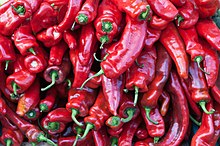
Распространение в Азии
Распространение перца чили в Азии произошло благодаря его завозу португальскими торговцами, которые — зная о его торговой ценности и сходстве с остротой черного перца — продвигал свою торговлю на азиатских торговых путях пряностей. Он был завезен в Индию португальцами в конце 15 века. В 21 веке азиатская кухня перец чили широко используется в разных регионах.
Производство
| Производство зеленого перца чили — 2016 | |
|---|---|
| Регион | (миллионы тонн ) |
| 17,4 | |
| 2,7 | |
| 2,5 | |
| 2,3 | |
| 2,0 | |
| 1,1 | |
| 0,9 | |
| Весь мир | 34,5 |
| Источник: FAOSTAT из Организации Объединенных Наций |
В 2016 г. 34,5 млн тонн зеленого перца чили и 3,9 миллиона тонн сушеного перца чили было произведено во всем мире. Китай был крупнейшим производителем зеленого перца чили в мире, обеспечивая половину мирового производства. Мировое производство сушеного перца чили составляло примерно одну девятую от производства свежего перца, возглавляемого Индией с 36% мирового производства.
Виды и сорта
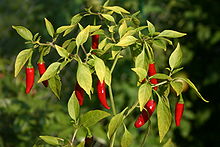
Там пять одомашненных видов перца чили. Capsicum annuum включает много распространенных разновидностей, таких как сладкий перец, воск, кайенский перец, халапеньо, тайский перец, чилтепин и все формы Нью-Мексико, чили. Capsicum frutescens включает malagueta, tabasco, piri piri и малавийский камбузи. Capsicum chinense включает самые острые перцы, такие как naga, habanero, Datil и Scotch bonnet. Capsicum pubescens включает южноамериканский перец рокото. Capsicum baccatum включает южноамериканский перец аджи.
Хотя существует всего несколько широко используемых видов, существует множество сортов и способов приготовления перца чили, которые имеют разные названия для кулинарного использования. Зеленый и красный сладкий перец, например, являются одним и тем же сортом C. annuum, незрелые перцы являются зелеными. К этому же виду относятся халапеньо, поблано (который в высушенном виде называется анчо), Нью-Мексико, серрано и другие сорта.
Перцы обычно делятся на три группы: сладкий перец, сладкий перец и острый перец. Считается, что самые популярные разновидности перца попадают в одну из этих категорий или являются чем-то средним между ними.
Интенсивность

Вещества, которые дают перец чили перцы их остротой (острым жаром) при проглатывании или местном применении являются капсаицин (8-метил-N-ваниллил-6-ноненамид) и несколько родственных химических веществ, вместе называемых капсаициноидами. Количество капсаицина зависит от сорта и условий выращивания. Стручки перца, подверженного водному стрессу, обычно становятся более крепкими. Когда растение хабанеро подвергается стрессу, например, из-за поглощения небольшого количества воды, концентрация капсаицина увеличивается в некоторых частях плода.
Когда перец употребляется в пищу млекопитающими, такими как люди, капсаицин связывается с болевыми рецепторами во рту и горле, потенциально вызывающими боль через спинномозговые реле к стволу мозга и таламусу, где ощущается тепло и дискомфорт. Интенсивность «тепла» перца чили обычно указывается в единицах тепла Сковилла (SHU). Исторически сложилось так, что это была мера разбавления количества экстракта чили, добавленного в сахарный сироп, до того, как его тепло стало необнаружимым для группы дегустаторов; чем больше он должен быть разбавлен, чтобы его нельзя было обнаружить, тем мощнее сорт и, следовательно, выше рейтинг. Современный метод — это количественный анализ SHU с использованием высокоэффективной жидкостной хроматографии (ВЭЖХ) для прямого измерения содержания капсаициноидов в разновидностях перца чили. Чистый капсаицин представляет собой гидрофобное, бесцветное, без запаха и воскообразное твердое вещество при комнатной температуре, его размер составляет 16 000 000 SHU.
Капсаицин вырабатывается растением в качестве защиты от хищников млекопитающих и микробов, в частности гриба fusarium, переносимого гемиптерановыми насекомыми, которые атакуют некоторые виды перца чили, согласно одному исследованию. В перце количество капсаицина увеличивалось пропорционально ущербу, нанесенному грибковыми хищниками семенам растения.
Перцы обыкновенные

Широкий диапазон интенсивности обнаружен в часто используемые перцы:
| болгарский перец | 0 SHU |
| зеленый чили Нью-Мексико | 0–70,000 SHU |
| Фресно, халапеньо | 3,500–10,000 SHU |
| Cayenne | 30,000–50,000 SHU |
| Пири пири | 50,000–100,000 SHU |
| Хабанеро, Шотландский капот, птичий глаз | 100,000–350,000 SHU |
Известные острые перцы чили
Некоторые из самых горячих перцев чили в мире:
США | Перец X | 3,18M SHU (*)
Соединенное Королевство | Дыхание Дракона | 2.4M SHU (*)
США | Каролина Рипер | 2.2M SHU (*)
Тринидад и Тобаго | Тринидадский скорпион Моруга | 2,0M SHU (*)
Индия | Бхут джолокия (Призрачный перец) | 1,58 млн SHU
Тринидад и Тобаго | Тринидадский Скорпион Бутч Т | 1.463M SHU
Соединенное Королевство | Нага Гадюка | 1,4M SHU
Соединенное Королевство | Бесконечный перец чили | 1.2M SHU
ПРИМЕЧАНИЕ: Заявления SHU, отмеченные звездочкой (*), не подтверждены Книгой рекордов Гиннеса.
Использует
Кулинарное применение

Стручки перца чили технически являются ягодами. В свежем виде их чаще всего готовят и едят как овощ. Целые стручки можно высушить, а затем измельчить или измельчить в порошок чили, который используется в качестве специи или приправы. Перец чили можно сушить, чтобы продлить срок его хранения. Перец чили также можно консервировать, засолив стручки в масле, погрузив стручки в масло или засолив.
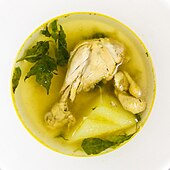
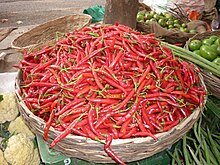
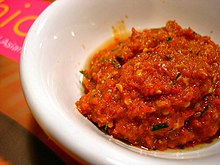

Многие свежие чили, такие как поблано, имеют прочную внешнюю оболочку, которая не разрушается при приготовлении. Иногда перец чили используют целиком или крупными ломтиками путем обжаривания или других средств образования пузырей или обугливания кожи, чтобы не сварить целиком находящуюся под ними мякоть. При охлаждении кожица обычно легко соскальзывает.
Листья всех видов Capsicum съедобны. Хотя почти все другие пасленовые культуры содержат токсины в листьях, перец чили — нет. Листья, которые слегка горькие и далеко не такие острые, как фрукты, в филиппинской кухне готовят как зелень, где их называют dahon ng sili (буквально «листья чили»). Они используются в курином супе тинола. В корейской кухне листья могут использоваться в кимчи. В японской кухне листья готовят как зелень, а также готовят в стиле цукудани для сохранения.
Во многих мексиканских блюдах, в том числе в вариациях chiles rellenos, используется весь перец чили. Сушеный цельный перец чили можно восстановить перед измельчением до пасты. чипотле — это копченый, сушеный, спелый халапеньо. В северных мексиканских штатах Синалоа и Сонора, перец чилтепин (дикий перец) используется в сырах и супах для придания остроты блюдам. В южной части Мексики соус мол используется с сушеным чили, например, анчо и перцем чипотле. Чили используется в сальсе. Мексиканские домохозяйства обычно выращивают растения чили для приготовления пищи.
В Индии большинство домашних хозяйств всегда держат под рукой запас свежих острых зеленых чили и используют их для придания вкуса большинству карри и сухих блюд. Обычно его слегка обжаривают на масле на начальных этапах приготовления блюда. В некоторых штатах Индии, например, в Раджастане, готовят целые блюда только из специй и перца чили.
Чили — основной фрукт в Бутане. Бутанцы называют этот урожай эма (на дзонгкхе) или соло (на шарчопе). Рецепт эма датси полностью готовится из чили, смешанного с местным сыром.
Перец чили присутствует во многих кухнях. Некоторые известные блюда, помимо упомянутых в других местах этой статьи, включают:
- соус арраббьята из Италии — соус на основе томатов для пасты, всегда включающий сушеный острый перец чили.
- соус Путтанеска на основе томатов с оливками, каперсами, анчоусами и, иногда, перцем чили.
- Паприкаш из Венгрии использует значительное количество мягких, измельченных сушеных чили, известных как паприка, в тушеной курице.
- Chiles en nogada из региона Пуэбла в Мексике использует свежий мягкий перец чили, фаршированный мясом и залитый сливочно-ореховым соусом.
- Блюда карри обычно содержат свежий или сушеный перец чили..
- Джамбалайя — это блюдо каджунского происхождения, в котором ароматы курицы, креветок и колбасы Андуй усиливаются кайенским перцем. Джамбалаю также иногда подают с региональным острым соусом, приготовленным из перца табаско.
- Jerk Chicken готовится в Карибском регионе Ямайки, вкус блюда благодаря чили Scotch Bonnet Chiles, душистому перцу и тимьяну.
- Цыпленок кунг пао (китайский : 宫保鸡丁 gōng bǎo jī dīng) из Сычуань региона Китая использует маленькие горячие сушеные чили, кратковременно обжаренные в масле, для добавления специй. к маслу, которое затем использовалось для жарки.
- Mole poblano из города Пуэбла в Мексике использует несколько разновидностей сушеных чили, орехов, специй и фруктов для приготовления густого темного соуса для птица или другое мясо.
- Нам Фрик — традиционные тайские пасты и соусы чили, приготовленные из нарезанных свежих или сухих перцев чили и дополнительных ингредиентов, таких как рыбный соус, лайм сок и зелень, а также фрукты, мясо или морепродукты.
- ‘Nduja, более типичный пример итальянских пряных деликатесов из региона Калабрия, — мягкая свиная колбаса, приготовленная «горячими» добавление местного сорта перца халапеньо.
- Paprykarz szczeciński — это польская рыбная паста с рисом, луком, томатным концентратом, растительным маслом, порошком перца чили и другими специями.
- Pipérade — это блюдо из баскского региона Франции, в рецепте которого используется Piment d’Espelette.
- Sambal terasi или sambal belacan — традиционный индонезийский и Малайская горячая приправа, приготовленная путем обжаривания смеси в основном измельченных сушеных перцев чили с чесноком, луком-шалотом и ферментированной креветочной пастой. Он обычно подается с блюдами из риса и особенно популярен в сочетании с хрустящими обжаренными на сковороде икан тери или икан билис (сушеные анчоусы), когда он известен как самбал тери или самбал икан билис. На индонезийском архипелаге существовали различные варианты самбала, в том числе самбал баджак, самбал олек, самбал пит (приготовленный из зеленой вонючей фасоли ) и самбал пенцит (приготовленный из незрелого зеленого манго).
- сом там, салат из зеленой папайи из тайской и лаосской кухни, традиционно имеет в качестве ключевого ингредиента пригоршню нарезанного свежего острого тайского перца чили, растертого в ступке.
- Тавук Кебаби использует мяту и перец Алеппо в качестве маринада, который придает аромат нарезанным на вертеле кусочкам курицы, которые поджариваются на гриле перед подачей.
Свежие или сушеные чили часто используются для приготовления острого соуса, жидкого приправа — обычно разливаемая в бутылки, когда она имеется в продаже, — которая придает остроту другим блюдам. Горячие соусы используются во многих кухнях, в том числе харисса из Северной Африки, масло чили из Китая (известное как раю в Японии) и шрирача из Таиланда. Сушеный перец чили также используется для приготовления растительного масла.
Декоративные растения
Контраст цвета и внешнего вида делает растение чили интересным для некоторых как чисто декоративное садовое растение.
- Черный жемчужный перец : маленькие плоды вишневой формы и листья от темно-коричневого до черного.
Черный жемчужный перец
- Черный венгерский перец: зеленая листва, подчеркнутая фиолетовыми прожилками и фиолетовыми цветами, плоды в форме халапеньо
- Епископский коронный перец, Рождественский болгарский перец: назван так за его отчетливую трехстороннюю форму, напоминающую красную епископскую корону или красный рождественский колокольчик
Психология
Психолог Пол Розин предполагает, что употребление перца чили является примером «ограниченного риска», такого как катание на американских горках, при котором можно наслаждаться экстремальными ощущениями, такими как боль и страх, поскольку люди знают, что эти ощущения на самом деле не вредны. Этот метод позволяет людям испытывать экстремальные ощущения без какого-либо значительного риска телесных повреждений.
Лекарственное средство
Капсаицин, химическое вещество в перце чили, которое делает его горячим, используется в качестве обезболивающего в мазях для местного применения, спреях для носа и кожных пластырях для облегчения боли.
Химические раздражители
Капсаицин, выделенный из перца чили, используется при производстве перцового аэрозоля и слезоточивый газ в качестве химических раздражителей, формы менее смертоносного оружия для контроля над непослушными людьми или толпами. Такие продукты имеют значительную вероятность неправильного использования и могут привести к травмам или смерти.
Защита сельскохозяйственных культур
Конфликты между фермерами и слонами уже давно широко распространены в Африке и Страны Азии, где слоны каждую ночь уничтожают посевы, совершают набеги на зернохранилища, а иногда и убивают людей. Фермеры обнаружили, что перец чили эффективен для защиты сельскохозяйственных культур от слонов. Слоны не любят капсаицин, химическое вещество в перце чили, которое делает их горячими. Поскольку у слонов большая и чувствительная обонятельная и носовая система, запах перца чили причиняет им дискомфорт и мешает питаться растениями. Посадив несколько рядов острых фруктов вокруг ценных культур, фермеры создают буферную зону, через которую слоны не хотят проходить. Для этой цели также используются бомбы из навоза чили. Это кирпичи, сделанные из смеси навоза и перца чили, которые сжигаются, создавая ядовитый дым, не позволяющий голодным слонам попасть на поля фермеров. Это может уменьшить опасную физическую конфронтацию между людьми и слонами.
Пищевая защита
Птицы не обладают такой чувствительностью к капсаицину, потому что он нацелен на специфический болевой рецептор у млекопитающих. Перец чили едят птицы, живущие в естественной среде обитания перца чили, что, возможно, способствует распространению семян и выработке защитного капсаицина в перце чили.
Пищевая ценность
| Пищевая ценность на 100 г (3,5 унции) | |
|---|---|
| Энергия | 166 кДж (40 ккал) |
| Углеводы | 8,8 г |
| Сахар | 5,3 г |
| Пищевые волокна | 1,5 г |
| Жиры | 0,4 г |
| Белки | 1,9 г |
| Витамины | Количество % DV |
| Эквивалент витамина A бета-каротин | 6%48 мкг 5%534 мкг |
| Витамин B6 | 39% 0,51 мг |
| Витамин C | 173% 144 мг |
| Минералы | Количество % DV |
| Железо | 8%1 мг |
| Магний | 6%23 мг |
| Калий | 7%322 мг |
| Другие составляющие | Количество |
| Вода | 88 г |
| Капсаицин | 0,01 г — 6 г |
|
Ссылка на запись в базе данных USDA |
|
|
|
| Процентные значения приблизительно рассчитаны с использованием рекомендаций США для взрослых.. Источник: База данных питательных веществ Министерства сельского хозяйства США |
В то время как красный перец чили содержит большое количество витамина C (таблица), другие виды содержат значительные количества провитамина A бета-каротин. Кроме того, перец является богатым источником витамина B 6 (см. Таблицу).
Правописание и использование
Три основных варианта написания: чили, чили и чили, все они распознаются словарями.
- Чили широко используется в исторически англоязычных регионах США и Канады. Однако его также часто используют как сокращенное название для chili con carne (буквально «чили с мясом»). Большинство версий приправлено порошком чили, что может относиться к чистому сушеному измельченному перцу чили или к смеси, содержащей другие специи.
- Чили — наиболее распространенное испанское написание в Мексике и некоторых других. в других странах Латинской Америки, а также в некоторых частях США и Канады, в которых упоминается именно это растение и его плоды. На юго-западе США (особенно в Нью-Мексико) чили также обозначает густой, пряный соус без уксуса, приготовленный из этого фрукта, доступный в красных и зеленых вариантах и подаваемый с местной едой, а чили обозначает мясное блюдо. Множественное число — чили или чили.
- Чили был первоначальным романизированным словом науатль для обозначения фруктов (chīlli) и является предпочтительным британским написанием в соответствии с Оксфордский словарь английского языка, хотя в нем также перечислены варианты чили и чили. Перец чили (и его перцы во множественном числе) — наиболее распространенное написание в Австралии, Индии, Малайзии, Новой Зеландии, Пакистане, Сингапуре и Южной Африке.
Название растения почти наверняка не связано с Чили, страна, имеющая неопределенную этимологию, возможно, связанную с местными топонимами. Чили, Колумбия, Эквадор, Панама, Перу, Доминиканская Республика и Пуэрто-Рико — некоторые из испаноязычных стран, где перец чили известен как аджи, слово происхождения таино. Хотя перец первоначально относился к роду Piper, а не Capsicum, последнее употребление включено в английские словари, включая Oxford English Dictionary (смысл 2b перца) и Merriam-Webster. Слово перец также часто используется в ботанических и кулинарных областях в названиях различных видов растений чили и их плодов.
Галерея
хабанеро перец
Незрелый перец чили в поле
Сорт Black Pearl
перец кубанелле
бумага из спелого перца чили с семенами
Перец чили виски на Карибском рынке
Сушка перца чили в Катманду, Непал
Удаление прожилок и семян с сушеного чили в Сан-Педро Атокпан
Хлопья сушеного перца чили и свежий чили
Перец чили окунуться в традиционный ресторан в Аммане, Иордания
Сушеные тайские перцы чили с высоты птичьего полета
Зеленые чили
Гунтур чили сушка на солнце Андхра-Прадеш, Индия
Сушеный перец чили в Имогири, Джокьякарта, Индонезия
Чили чили в Нью-Мексико сушеный на заводе в Месилья, Нью-Мексико
Вино из перца чили из Вирджинии
Ристрас сушеных перцев чили в Аризоне.
Перцы чорицеро
маринованные чили в Индии
Пеперончино чили в Тропеа, Италия с табличкой «Il Viagra Calabrese» ( калабрийская виагра ).
См. Также
Пищевой портал
- Чили-граната, тип оружия, сделанный из перца чили
- Хэтч, Нью-Мексико, известный как «Чилийская столица мира»
- История шоколада, который майя пили с молотым перцем чили
- Международные ценители зеленого и красного Чили, организация по продвижению перца чили
- Peppersoup
- Ристра, композиция из сушеных стручков перца чили
- Сальса (соус)
- Сладкий соус чили, приправа для придания еде сладкого, мягкого теплого вкуса
- Табу на еду и напитки, который в некоторых культурах включает перец чили
Ссылки
Внешние ссылки
| Найдите chili в Wiktionary, бесплатном словаре. |
- Культуры растений: ботаника, история и использование перца чили
- Институт перца Чили при Университете штата Нью-Мексико
- Стручковый перец: I Новаторское использование древних культур
- Чили: La especia del Nuevo Mundo (статья Хермана Октавио Лопеса Рикельме о биологии, питании, культуре и медицине. На испанском языке)
- Список острого перца Список разновидностей перца чили, упорядоченных по рейтингу жары в единицах тепла Сковилла (SHU)
Всего найдено: 17
Добрый день! Подскажите, пожалуйста, почему правильно пишется «перец-горошек»? Нигде не могу найти айти ответ на этот вопрос. Заранее спасибо.
Ответ справочной службы русского языка
Правило можно прочитать в информационно-поисковой системе «Орфографическое комментирование русского словаря».
Здравствуйте! Подскажите, пожалуйста, какого рода слово халапеньо?
Ответ справочной службы русского языка
Это слово мужского рода (по родовому слову перец).
Добрый день. Подскажите, пожалуйста, как правильно называется блюда — фаршированные перцы или фаршированный перец? Я всегда считала, что «фаршированные перцы» (ведь он не один делается), и вокруг все так говорят, а сейчас вижу, что в интернете даже на очень серьёзных сайтах блюдо называется «фаршированный перец«, в единственном числе… И люди спорят, перцы или перец
Рассудите нас, пожалуйста!
Ответ справочной службы русского языка
Возможны оба варианта. Если Вы используете форму единственного числа, то имеете в виду перец как продукт. Если множественного, то отдельные овощи.
Добрый день. Какого рода будет «консервированн… чили»? Имеется в виду консервированный перец. Среднего или мужского?
Ответ справочной службы русского языка
Корректно: консервированный чили.
Здравствуйте, Грамота. Какое число употреблять в данном варианте предложения? На рынке продается перец как желтого, так и красного цвета (или цветов?).
Ответ справочной службы русского языка
Верно: …как желтого, так и красного цвета.
можно ли считать терминами слова из предложения: Глоссарий по теме «еда» содержит в себе названия основных продуктов на французском языке (видов мяса: «говядина», «свинина», «телятина», «баранина», приправ: «горчица», «уксус», «перец» и т.д.). Студенты должны перевести эти термины». Пожалуйста, ответьте!
Ответ справочной службы русского языка
Термин — это слово или сочетание слов, являющееся точным обозначением определенного понятия какой-либо специальной области науки, техники, искусства, общественной жизни. Приведенные слова не специальные, а общеупотребительные, поэтому называть их терминами не вполне верно.
Как склоняются еврейские фамилии Перец и Перес? В частности, допустимо ли в русскоязычных регионах склонение фамилии Перец по тем же канонам, что и нарицательного существительного «перец«?
Ответ справочной службы русского языка
Нет, склонение фамилии Перец с выпадением гласной (Перца, Перцу) некорректно. Нужно склонять без выпадения гласной: Переца, Переса. Напомним, что склоняется только мужская фамилия.
Режет слух множественное число слова «перец«. Надеюсь, что норма осталась прежней — только единственное?
Ответ справочной службы русского языка
Слово перец в некоторых своих значениях может иметь формы мн. ч.
Добрый день! Подскажите, пожалуйста, склоняется ли фамилия Перец? На мой взгляд — женская не склоняется, мужская склоняется.
Ответ справочной службы русского языка
Вы правы.
Скажите, почему слово ПЕРЕЦ теряет -е в корне при склонении по падежам, а слово МЕРТВЕЦ не теряет букву -е.
Г. П. Коган
Ответ справочной службы русского языка
Чередование [е] с нулем звука (выпадение гласного) происходит в существительных первого (в школьной практике — второго) склонения, основы которых оканчиваются на _-ец_ (включая и суф. _-ец_): _венец — венца, мизинец — мизинца, перец — перца_.
Чередование (выпадение) не происходит, если сочетанию _-ец_ предшествует сочетание согласных (в данном случае — _ртв_): _спец — спеца, хитрец — хитреца, мертвец — мертвеца_.
Какова этимология выражения «ясен пень (перец)»?
Вроде, в контексте, всегда понятно что это означает,но если вдуматься, то смысла никакого нет.
Оч любопытно
Ответ справочной службы русского языка
В «Словаре русского арго» В. С. Елистратова указано: _Ясный месяц, ясный перец_ — эвфемизм от нецензурного.
Предложение:
Перец сушится в специальных открытых хижинах – апацха, в центре которых горит костер.Подскажите пожалуйста:
1)нужны ли кавычки у слова «апацха», если это слово взято из абхазского языка
2)нужно ли изменить окончание в нем на «апацхах»
Ответ справочной службы русского языка
Это слово лучше не склонять, можно писать без кавычек. Однако если Вы хотите подчеркнуть необычность названия, кавычки допустимы.
Добрый день, подскажите, пожалуйста, как все-таки корректней: «перецифровка» или «переоцифровка»? Большое спасибо.
Ответ справочной службы русского языка
Корректны оба варианта.
Подскажите, как правильно: молотый черный перец или черный молотый перец
Ответ справочной службы русского языка
Корректно: молотый черный перец или черный перец молотый.
Как правильно:перец горошек или перец горошком?
Как правильно:Реутов или Реутово и где ставить ударение?
Где ставить ударение: Балашиха?
Ответ справочной службы русского языка
Правильно: перец-горошек, РЕутов (город в Московской области, ударение на первый слог), БалашИха.


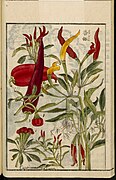



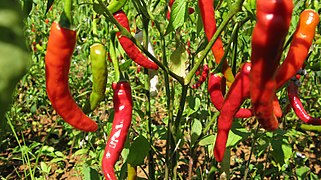





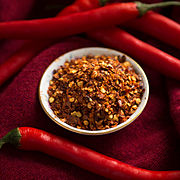
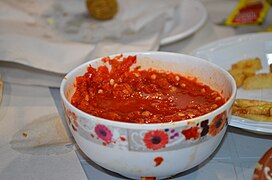
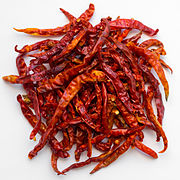
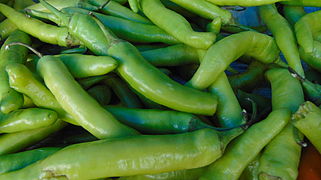

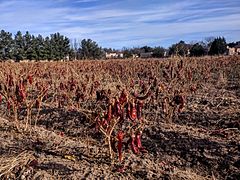

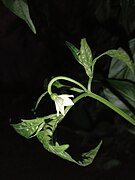


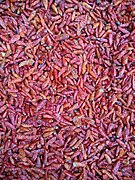
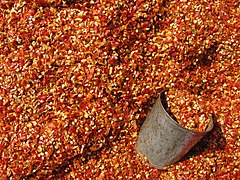

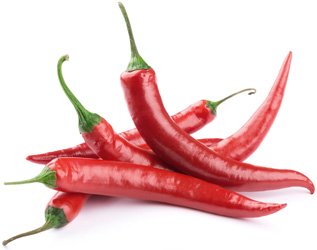




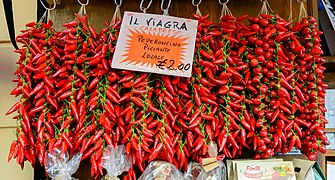
 Рассудите нас, пожалуйста!
Рассудите нас, пожалуйста!